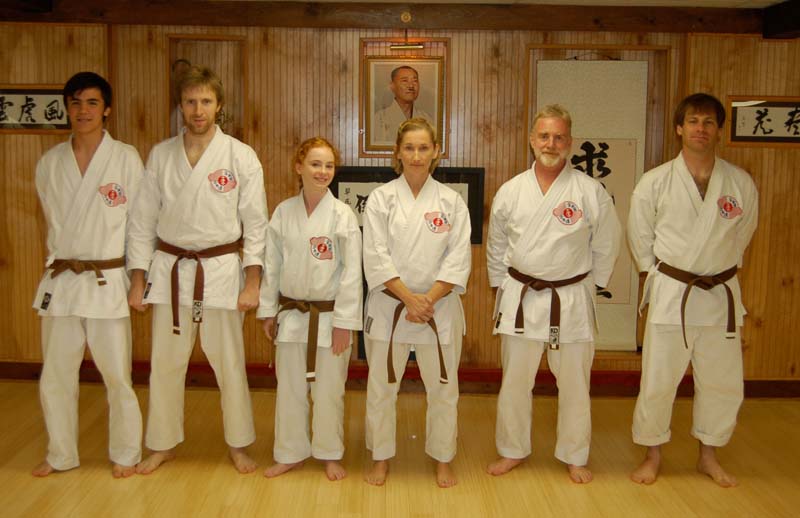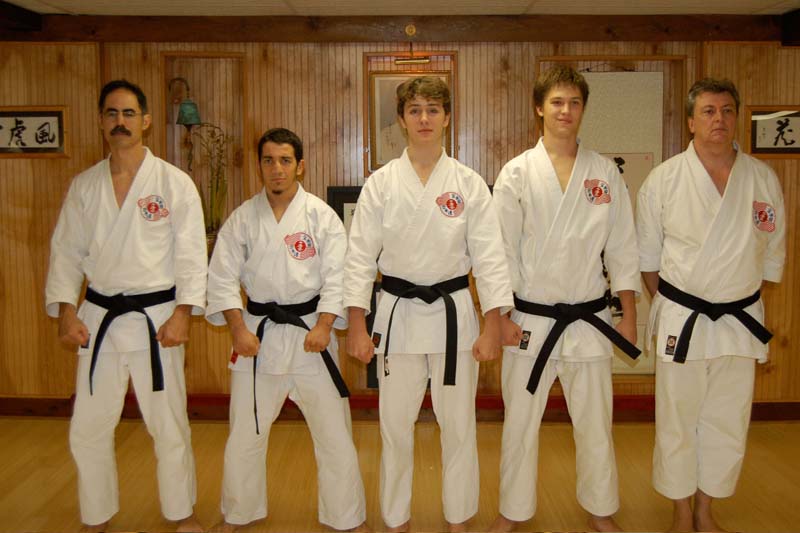U.S. HISTORY (2006 - 2010)
KANGEIKO 2006: NANGYO-DO "THE WAY OF HARDSHIP"
Mark Chisenhall
Yoseikan Hombu Dojo

The concept of Kangeiko is meant to be a catalyst for enlightenment through rigorous training in harsh conditions. In Japan training sessions are conducted early in the morning, approximately 0600, for about 2 hours everyday for one
week. Generally it is very cold and some of the training will take place outside. Another type of training that is related to our Kangeiko is the Zen Buddhism Daiseishin. This training is also rigorous and involves sitting in seiza
for 45-minute periods with 15 minute walking sessions. All of this is done while contemplating riddles, chanting, or getting hit with stick. It is from these traditions that I believe Hanshi Dometrich created the Chito-ryu version
of Kangeiko. The result is to cross a threshold in your training, either mental or physical.
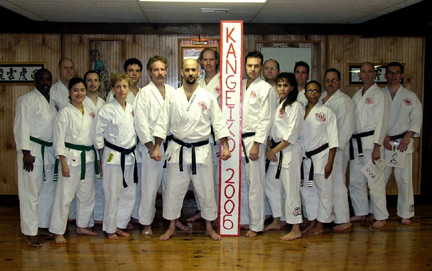
Kangeiko has been held at the Yoseikan hombu for 27 years. The first 25 of those years it was primarily coordinated by Hanshi. Shihan Khalily has spearheaded the past two years. Formerly of Yoseikan II Cincinnati and now proudly
heading his own Takanoko dojo in Louisville, KY. Shihan Khalily has grasped the torch tightly and ran with it. The rules are spaghetti dinner at 6:30, speech at 9:30, lights out the night before at 10:00 p.m.; wake up at about 2:30.
Training begins at 3:00 and finish at 9:00. Hanshi created many great traditions, such as 1,000 punches, 1,000 blocks and 500 kicks. Training is capped off with a barefoot jog that covers 4-6 blocks depending. When it snows the feet
are usually numb before the halfway point. Upon return hot tea, pictures, and a huge breakfast prepared by Okusan and company.
This year was very different for a few reasons. First of all, Kangeiko is supposed to take place on the coldest day of the year and amazingly generally this is true. However, this season has been blessed by very mild temperatures
making 2006 the warmest Kangeiko of all time. Secondly, last year Shihan Khalily created a tradition of kicking off the “welcome speech” with a sake toast. As a symbol of his training every step of the way with the
students, Shihan Khalily toasts with each student individually one cup of sake. Those under 21 or those who choose, drink water. Shihan Khalily likes to have a theme for kangeiko, this year he called upon fellow martial artist Dave
Lowry to create a theme through his knowledge of Japanese calligraphy to epitomize our Kangeiko 2006. Thus, Nangyo-do was presented on a certificate in beautiful kanji and adorning the backs of the shirts made especially for the
annual event. Nangyo-do is translated as “the way of hardship.”

The training itself consisted of “secret ninja techniques” of which I was sworn to secrecy. You will have to attend next year to find out what happens. Suffice it to say that before, during and after you have very mixed
emotions concerning the decision to partake in such an event. No matter what the conditions, 6 hours of continuous training takes a toll on the body and the mind. As Shihan Khalily warned in the “welcome” speech, the
mind will play tricks on you. He also stated that the physical portion would not be as brutal as the psychological. It was not targeted to test only the strong, nor was it survival of the fittest. It was a sharing of camaraderie,
brotherhood and spirit. This year’s headcount was a little lower than previous years, but the spirit and strength of character of those participating was as great as any.
Keen Energy on a Sunny Reprieve
Mina K. Ludwig, Esq.
Yoseikan II Cincinnati
Unless your heart is wide open and your mind is orderly, you cannot be expected to be able to adapt responsively without limit… The Art of War.
This is but one reason why we escape every February to train with our brothers and sisters in sunny Florida. This year’s Florida clinic was hosted by Sensei James Acampora over President’s Day weekend, February 17th
–19th. James and his students put together a seamless and enjoyable weekend of events. The hotel accommodations were first rate. The room for the clinic and banquet was spacious, well appointed and had great acoustics. The
site for the dawn beach workouts was perfect and picturesque. Our founders and Chairman were well cared for with beautiful flowers and welcome baskets to greet them. No detail was overlooked. As if all of that were not enough, there
were three great training opportunities.
Morning energy is keen... The Art of War.
On Saturday, February 18th at 6:30 am, eighteen bright eyed students gathered at the beach to train in the sand. The surf and the sun breaching the horizon made for an uplifting training experience. Kyoshi Hawkins devised a
curriculum that was appropriate for all ranks. Shihan Khalily and myself assisted Kyoshi Hawkins. Sensei Acampora opted to take advantage of this opportunity to train and left the teaching assignments completely up to Kyoshi. What a
great example this was to his students. The highlight had to be our practice of Passai kata. Kyoshi worked this into the curriculum when the sun had reached the optimal height.

Later that day, after some food and a nap in the sun, thirty-two students gathered in a huge pavilion for a four-hour Chito Ryu clinic. James and his crew have officially set the standard for the kamizas of the future with a larger
than life, six-foot portrait of O Sensei displayed on a big screen television. Well done.
Shihan Khalily kindly provided the pipes for Hanshi’s curriculum. Adding his own quintessential flare, Shihan Khalily ran the green, brown and black belts through exactly what Hanshi demanded. It was a good hard workout
that was informative about Chito Ryu basics as well as the intricacies and applications of those basics. Several kata were reviewed for the betterment of all and, certainly, we did not pass up the opportunity to bang each other up a
bit with some basic kumite and applications. Still sporting the bruises…ah!…invigorating stuff this karate.
White, yellow and orange belts enjoyed a rotation of instructors which included Wes Ernest, Laura Deck, Matthew Scott and yours truly. It was a great opportunity for them to experience a variety of teaching styles as they prepared
for their kyu tests scheduled for after the clinic. For my part, I had a great time teaching a group of students who demonstrated volumes of spirit, heart and tenacity. They were beginners, two months to one year of experience, and
their excitement and enthusiasm were palpable. They were the epitome of sho shin – so willing and able to soak up all of the instruction and the collective energy. I’m certain they would have gone out to bite palm trees
if I bidden them to do so. (I did resist that particular temptation, this time) They all did their teacher, James Acampora, proud by performing well and passing their tests. Five beginners tested along with Karen Ruperto for ni kyu,
and a return friend from years ago, Gina Rossini, who once again more than earned the right to wear her first-degree black belt. Every one of them passed with flying colors. Nicely done guys and gals.
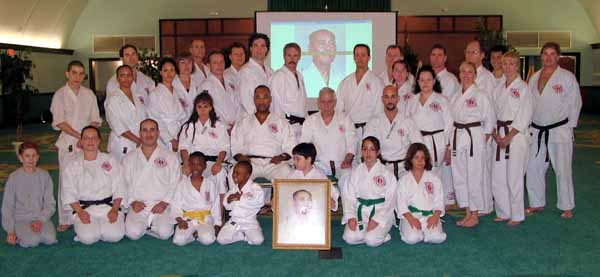
The dinner on the evening of the clinic was a great success. More than forty people attended and enjoyed food, drink, camaraderie and thoughtful entertainment. A big screen presentation of a Taiko drum performance provided the
background music for the meal. This was followed by a very moving speech by Sensei Binkley as well as a video montage prepared by Sensei Acampora and Sensei Levin all dedicated to the memory and honor of their teacher, Shihan Art
Rott.
Okusan received, along with a standing o, the Shihan Art Rott award for benevolence and devout service. Clearly she will cherish that token of appreciation. Beyond that, other awards and gifts were given. Frankly, I was too
caught up in the cool little stuff I received to pay attention. Saw some silly hats, not sure what else.
More keen energy at the crack of dawn on Sunday. This send off workout was also well attended and conducted by myself, Sensei Acampora and Sensei Matthew Scott. After a great warm up and kihon drills by Sensei Acampora, Sensei
Scott ran the crew through several of our homemade drills emphasizing empi, hiza gerri and open hand techniques. We ended the session with San Chin kata. The sand provided for great training experience in balance, shime, and
adjustment to uneven and shifting terrain. Our final seiza on the beach was particularly poignant and memorable.
There are many other stories in the naked city. These are simply the sanctioned tales. Remember, what happens in Florida stays in Florida. If you want the full scoop, you have a year to save your acorns to make it to the
Florida clinic next year. Plan ahead – you won’t regret it.
Hanshi Grants No Quarter
By: Mina K. Ludwig, Esq.
Yoseikan II Cincinnati
I suppose I am learning some of my lessons well, because I’m not too proud to admit that Hanshi almost killed me in the first hour of the 2006 Spring clinic. I’m not sure what he ate with his Wheaties on the morning of
March 18, but I hope he eats the same thing before the July and October clinics. What a sick, gluttons for punishment we’ve become.
Renshi Byers kicked off the clinic with some practical and butt-kicking warm ups. The cadence and the demand for excellence as we moved through various kihon was relentless and motivating. One would think we would have been
very well prepared for what came next.
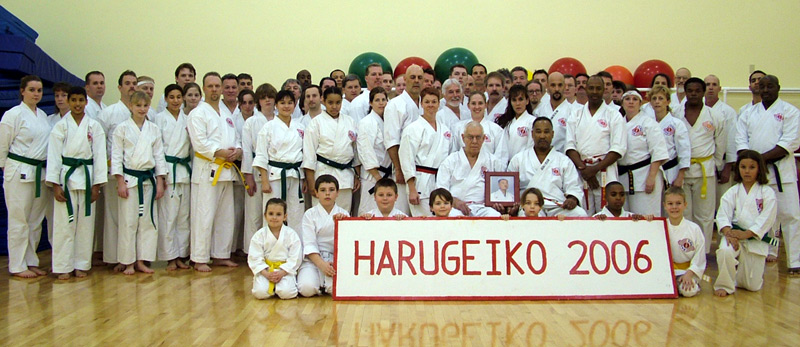
When Hanshi again assumed the helm, we were already dripping and huffing. Little did we know the true lung burn was yet to come. If you tell me you were not tired during Hanshi’s hour, you are either a liar, or you were not
working hard enough. I lost count on how many times we performed Passai, Chinto, Sochin and Tenshin. It became a blur especially as the bow out smoothly transitioned to the bow in. Amazing how much relief is offered merely by bowing
out and returning to hatchiji dachi before bowing in again to the next kata. No such quarter was offered to the Yudansha by Hanshi.
After who knows how long, Hanshi offered a demonstration in group timing by contingents from Alabama, Kentucky and Cincinnati; Sensei Cindy Webster (maiden name may be used in lieu of married name at any time - forever), Renshi
Kembre and myself, respectfully. I cannot speak for my fellow demonstrators, but I felt sure after the adrenaline rush of the demo compounded upon pre-existing exhaustion, I would end up demonstrating how to pass out.
Luck, or more likely, previous such butt whooping workouts from my own teacher, Kyoshi Hawkins, allowed me to catch my second wind and end the first hour feeling invigorated. Somewhere in this, a group picture was taken of a
very moist, red-in-the-face crowd. (There’s the disclaimer for all of us who were less than photogenic - you can thank me later.)
Meantime Renshi Beshears was working Ni Sei Shi Kata with the Green Belts, Renshi Wilhelm covered Passai with the Brown Belts and Renshi Wellbrock put the white, yellow and orange belts through the paces with the Taikyoku kata.
The next couple hours were well spent first with Renshi Wilhelm reviewing basic and advanced ukemi waza and with Renshi Beshears revamping the ju go ko. As I watched these two gentlemen fly through the air with the greatest of ease,
land with the appropriate thump then get up for more and more and more - I turned to my teacher and asked, ‘How old are these guys again?!?’ The closest thing to putting in a bottle what those two, Kyoshi Hawkins and
several others of our over- forty crowd have (just over forty, mind you) is to keep training and to seek more of these knee wobbling training sessions.
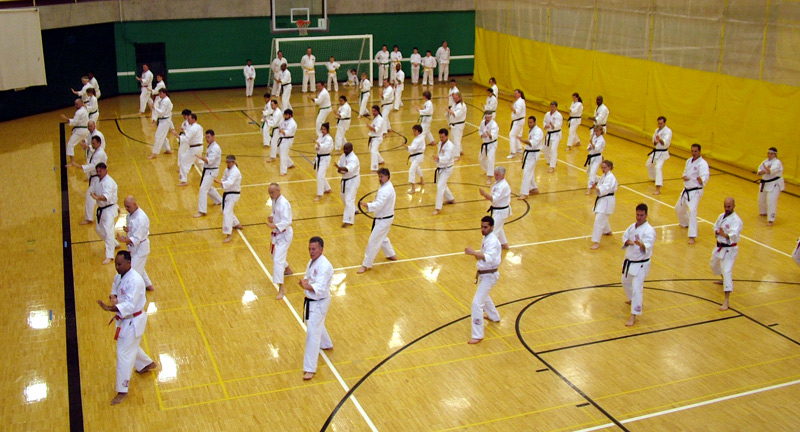
The final hour belonged to Hanshi who got our hearts thumping again with Taikyoku, san ban and kihon kumite. His admonishment that this could be our last training session, our last preparation before we are attacked served as
appropriate motivation to perform to our utmost. Ichi go ichi e, right?
Throughout the post warm-up hours, the kyu ranks were fortunate to receive very targeted instruction in smaller groups. Renshi Byers and Renshi Wellbrock provided very beneficial training for these groups with a much reduced ratio of
teacher to student. The result was that everyone, at some point, received one to one observation and instruction.
As always, thanks to Okusan for everything, to Kathy Webster for assisting Okusan, and to Sensei Elliot for securing the facilities. A very Happy Birthday to Hanshi was had by all. See you all at Shochugeiko come July. You may
want to amp up your cardio training.
DOKI, DOKI
Submitted by Gordon Levin
Yoseikan Dojo II of Orlando
Doki, Doki is a Japanese slang term that is an onomatopoeia (a word that describes the sound associated with its meaning; such as a cow’s “moo”, or a trigger’s “click”). Doki, Doki is meant to
describe your heartbeat in a state of surprise, anticipation, or nervousness. I think that this is the best way to describe my feelings as we headed toward Shochugeiko 2006. Sensei James Acampora and I always manage to talk about
karate for a good part of the 15 hour drive to Covington and this trip was no different, other then the happy addition of his daughter Destiny and Sempai Karen Ruperto to our crew. I must have been talking about Shochugeiko for 2
months at the dojo...you see, occasionally I need some external motivation to recharge my training batteries and a few classes at the hombu plus a 5 hour outdoor clinic are always “just what the doctor ordered”. I had
been working the graveyard shift lately, so it was an easy decision to drive all night so we could make Thurs. morning class at the hombu. We all took a few minutes out after our arrival to marvel at the gorgeous, new bamboo floor
of the lower deck. Congratulations go out to all who worked on it; it is a beauty to behold! Even after Sensei Chisenhall put my face on it a few times, I still loved it! Later on, the bottom of my feet also whispered a happy thank
you. Although we arrived late enough to warrant push-ups, Sensei Bank’s morning class was a great “welcome-back” - self-defense applications and joint-locks. Nothing like some nerve stimulation to overcome any
effects of being awake for over 24 hours. Thursday evening’s class by Sensei Ford was a gentle reminder that there is only so much oxygen in the hombu, so you better breathe it in quick before someone else gets it…I
very rarely cast an eye to the bucket on the wall at the hombu, but I must admit I glanced at it Thurs. night. After a casual Friday with the Ernest family (our eternally gracious hosts - won’t they ever get tired of us? We
sure hope not!), we were ready for the Saturday main event. While we all anxiously watched the weather reports, I somehow knew that our long tradition of never being stormed out of Shochugeiko would hold.
Here is where Doki, Doki always reaches its peak: Who will be teaching which sections? What new drills and pearls of wisdom will we be bringing back to the Orlando dojo? Who will I get to partner with in two-person drills? All
these thoughts and more always run through my mind at the big events as we bow in - I know, I know; too much thinking….

What a great start! - Katas; starting with Chinto and working upward; Sochin, Tenshin, and San Shi Ryu. Thank you to Shihans Khalilly and Ludwig (here’s a huge secret I’m willing to share: If you are asked if you want to
break out of a group of 50 to train with a Shihan in a 3 to 1 student-sensei ratio, DO IT!) Thanks also to Kyoshi Hawkins and all the higher ranking Senseis for offering corrections and teaching katas to the kyu ranks. The first
hour absolutely flew by (as a matter of fact, they all did). Sensei Chisenhall taught what several karatekas stated they thought was the best section of the day: hip drills for improving snap. Am I crazy to think he created that
drill just for me? I’ll delude myself for now. Meanwhile the kyu ranks were diving into more katas and ashi techniques. All great stuff.
Next came our old bo favorite: Sakugawa Non Kon Sho. I was glad we had been working the bo occasionally in the previous months in Orlando; no major embarrassing moments for me and not too many changes - I started having
flashbacks to doing Sakugawa at Camp Ernest in 1995… or was it 1996? All I remember is it was really hot…okay, back to the present - Was that some karatekas working on Shushi Non Kon Sho over there on the side? Yup…Cool.
Huh? Another section over? Just like that? You bet’cha.
Okay, on to the next section: Hen Shu Hos. Thank goodness none of the Senseis just started screaming out numbers and yelling GO! I believe everyone there worked on this, but it never seemed like we had enough time for each one
(probably because I could have done each one another 50-60 times and I’d still want to work on it more). We barely got through the first 7 or so and there it was again! End of the section…Unbelievable.
Oh well, final section - Renshi Beshears apparently had a big stockpile of water balloons he needed to get rid of in a bad way. Although the water felt good and the drill was fun, I kept thinking: He’s not going to have
us do San-Bon kumite with thumb-tacked gloves, is he? Glad to say, everyone escaped without puncture marks and now I have a lot to think about regarding reaction drills as we head back. Plus, now I know just how bad my depth
perception is: real bad. So, after the usual bow out, pictures, feast, and hugs goodbye, another hugely successful Shochugeiko has been put to bed. Normally after this clinic, I feel like I’ve done enough karate for the day;
time to rest. For some reason at the end of this one, I was ready to go for another couple of hours at least….What does that mean? Is that “success with a capital S” or was it just me? Perhaps because it turned
into such a beautiful day? I give up on trying to answer that one. Need more proof of success? Destiny had to admit finally she had a good time…ouch, that had to hurt!
All I know is: I can’t wait for next Chito-kai event….Doki, Doki.
P.S. Some notable quotables:
“Great weather, great karate!”
“Everyone goes away with something!”
“I wanna train!”
“Stop acting like a yo-yo!”
P.S.S. West VA seminar right around the corner and National clinic and banquet after that…See y’all real soon.
West Virginia Clinic at Audra State Park
Tony DiTerlizzi
What can one say that hasn’t already been said about Audra State park? All that I have heard has been true. For me it was the long awaited trip to camp and workout. Having missed the others only to hear how awesome and
beautiful the area is, I had to make it this year. I’m an avid backpacker and camper and love nothing more than to be in the woods, especially with friends and family. I decided to make it a couple of days earlier to really
enjoy it. For me it was a 9-hour drive, but it went by pretty quick and before you know it I was there in the park looking for a familiar face. After my second dive through I ran into Sensei Schmidt, who pointed me in the direction
of our host’s campsite. With tent in hand I asked Sensei Messenger where my site was located, but being the gracious host that he is, he put me up at the Messenger Hilton (nice pop-up Mike). Also sharing the site was the
Drummond family with their pop-up, it was the best for this first timer. I even cooked a chicken Teriyaki dinner for Sensei Messenger, a good old Mountain Home freeze-dried backpacker’s meal I think he liked it. Next to their
site were Sensei Chisenhall and his family, who had been there all week. Across from them was the Lingo family who also had made it for the week. I spent the rest of the day visiting and checking out the park, it was just a great
time.
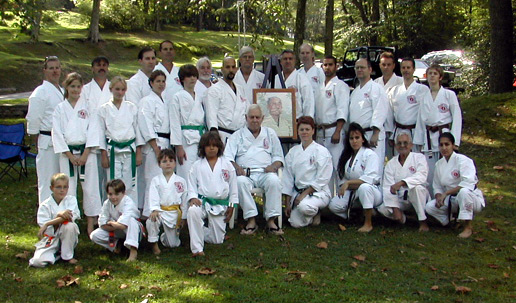
Hanshi and Okusan along with the Webster’s soon arrived. I went along with Sensei Messenger and Drummond to help get them settled in at Jackie’s brother’s place. The next day, Friday, was also a day of park
exploration with more visiting and checking out the river. In the evening was the spaghetti dinner that was being held at Sensei Cross’s brother’s retreat. Just awesome is all I can say about it and thanks to Sensei
Cross, who also did the cooking, and her brother for letting us use his place.
That night campfires were roaring and the weather was nice and cool, had to put on another blanket to keep warm, everybody was getting ready for the workout next morning.
Morning came and Sensei Messenger cooked maple flavored bacon, Cindy Drummond cooked the eggs and Sensei Drummond cooked his famous big fluffy pancakes. What a way to start the day, ummm good. We all made our way down to the
clearing, by the river for the workout. Hanshi and Okusan arrived and the clinic was on the way. Hanshi bowed us in and then the official group photo by Okusan was taken. Sensei Drummond warmed us up followed by an hour of basic’s
moving back and forth by Sensei Chisenhall, it was all good stuff. Next Hanshi took us through the paces doing kata. Starting with Taikyoku ichi all the way up to Tenshin. With emphasis on the higher Chito Ryu kata’s going
back to the way O-Sensei had taught him. After a short break we began again with Sensei Drummond going through Seikan no Migi Hidari and Kihon no Empi. After going through these several times we paired up and Sensei Drummond had us
doing some Bunkai using these katas. Good stuff Sensei. Then it was Sensei Messenger’s turn to work us. He started us off with some self-defense moves and Sensei Schmidt was the unfortunate one at the end of Sensei’s
demonstrations, sorry Don how did you become the lucky one. Sensei Po wanted that position, but I think Sensei Messenger was concerned that Sensei Po might be too much to handle. A lot of trash talk was going down the last two
nights on how things were going to go down, so I guess it was good that Sensei Schmidt stepped up, all in good fun. Then came the kumite. Sensei Messenger had us form the circle and started pairing up the combatants, pointing out
the do’s and don’t on what they were doing. As Hanshi was watching one thing he noticed that everybody lacked was good spinning back kicks. So up next was Shihan Khalily and the spinning back kicks. Pairing up he had us
doing 270 deg and 180 deg spinning back kicks. For me this was great, because my kicks always need some work and this was just what I needed. Along with some addition help from Sensei Messenger, I feel like I got a better
understanding on the mechanics. I also would like to thank my partner Sensei M. Lingo for his help and being on the receiving end of my erratic kicks. As usual these clinic just seem to fly by and the day was coming to an end. But
for me it wasn’t over until I got to do kata in the river. I have seen the pictures of the previous clinic and they always had the river workout and this was something I had to do. There were several who took the plunge and
after a long and hot workout the river felt so inviting and good. We ended up doing Niseishi in waist deep water, sweet. Next it was back to the campsite to get cleaned up and ready for the evening cookout.
That evening we all headed over to Sensei Messenger’s brother Bill’s cabin. I couldn’t thank them enough for letting us be there. Sensei Drummonds dad came over and did the cooking and the evening couldn’t
of been better. Just hanging out and visiting talking about the day’s workout, camping and getting together again. Then the West Virginia host’s introduced the forth ‘K’ of karate. You have kihon, kata, and
kumite and now we have karaoke. Hanshi started things off with an Elvis number and with a standing ovation he did and encore number for us. There were several participants, going all night long. Sensei Messenger even belted out a
number for us. I’m not sure what the campers across the river might of thought; maybe that someone was in pain. But one thing was for sure; everyone was having a great time. Well I think most of us should stick to karate and
not quit our day jobs. Like all good things they must come to an end. After a lot of hugs and good-byes we all departed.
The four days that I was there just flew by, just leaving you hungry for more and can’t wait to get back together again. In closing I would like to thank Sensei Drummond his wife Cindy, Sensei Messenger and his brother
Bill and Sensei Cross and her brother for everything. The hospitality was just over the top and these people went out of their way to make it the best and to make everyone welcome.
See everyone in October
Dai Nippon Butokukai Canadian Rensei Taikai
By: Sherry L. Kembre, Renshi
On October 5th, a team of 25 U.S. Chito-kai members and a team of 4 Shotokan members traveled to Toronto Canada to train, demonstrate, to make friends and to reunite with old friends.
Our first official day began with a practice for our demonstration. We had not been able to practice as an entire team, because many of our members are from as far away as Florida, Virginia, and West Virginia. The practicing was a
great challenge as there was no available room for us to use so we had to improvise by using a back hallway. We were not able to fully go through out kata, Seisan, and the worst part was that we were not able to practice walking on and
off the floor.
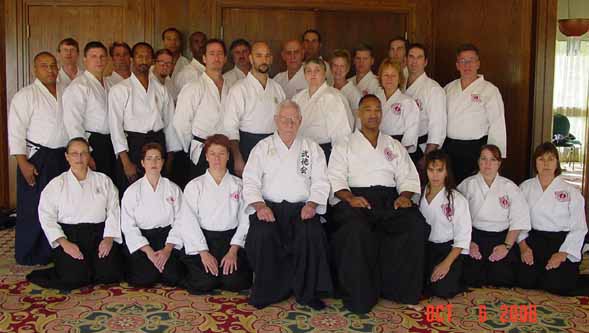
Later in the day we met as a team in the lobby for the marshalling of the karate-ka to the gymnasium for training. We were able to practice with three different instructors and get to experience other forms of karate-do. The Friday evening
offered us a time to mingle and share stories with our new friends. Later in the evening a few of the Midwest delegation ventured out to find some Chinese food. A small restaurant not more than 200 yards from the hotel proved to be a
great gathering place. Not only was it popular among many of the DNBK members but the food proved to be delicious and plentiful.
Saturday began with the team hoping to have a chance to practice walking on and off the floor; however that was not to be. We once again were marshaled to the gym. The honor of performing the opening kata, Harai no gi was bestowed
upon Sensei Shockey of California and our own Hanshi Dometrich. A dropped pin could have been heard in the gymnasium. The karate members watched in awe as Hanshi demonstrated his kata with determination, spirit and vigor. The Midwest
Team beamed with pride and with a few tears glistening in our eyes. The chairman of the International Division of the DNBK had Hanshi stand and he commented about Hanshi’s recent illness and how he executed his kata with
Bushido spirit. He expressed great pride in Hanshi and so did the members in the gym. A standing ovation and yelps of gratitude was given by the spectators, which only made the tears of pride and love more prevalent from our team. The tears
were short lived however we still had to demonstrate and we were not going to let Hanshi down.
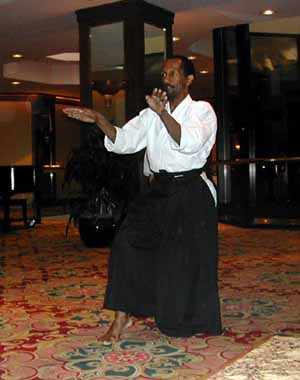 Even though we were not able to practice walking out we had very good formation. The Shotokan group headed by Sensei Dwight Holley demonstrated Bassai Dai kata and Sensei Holley impressed everyone with Hakaku kata
Even though we were not able to practice walking out we had very good formation. The Shotokan group headed by Sensei Dwight Holley demonstrated Bassai Dai kata and Sensei Holley impressed everyone with Hakaku kata
A few Chito-ryu basics were demonstrated before the U.S. Chito-kai team demonstrated O-Sensei’s favorite kata Seisan. A little added touch was the demonstration of the bunkai on the side by Jerry Wellbrock, Don Schmidt, Jerry
Beshears and Matt Scott. The demonstration ended with a four member team of Cyna Khalily, Mina Ludwig, Connie Kramer and Sherry Kembre demonstrating Chinto kata facing in towards each other. After we finished our demonstration, we
celebrated in the back hall with silent laughs of joy that we had reached our goal.
Now that the stress was over we looked forward to the banquet and a time to relax. Our team looked wonderful with our suits and DNBK ties. We were the only team in total matching suits and unity. The team met after dinner for a
group photo and a brief meeting. I noticed many members of the other teams watching our team. We definitely left a very impressive image.
The weekend was a total success. We were reunited and met new friends. We bonded with our own members and we were able to experience other forms of martial arts. Our next big adventure will be in April 2008, with a
demonstration in Kyoto. A demonstration that only a few people in the world can say that they have been apart of, the chance to workout and demonstrate in the Butoku Den.
Please continue working hard and plan to travel to Kyoto in 2008.
October 2006 Seminar and Banquet
By: Cyna Khalily, MD
October 22 2006 we celebrated what would have been O-Sensei’s 108th birthday. As usual the celebration consisted of a seminar, test, board meeting and banquet.
Along with Dometrich Hanshi and Hawkins Kyoshi this years special guest instructor was Dave Lowry. For those of you who are not familiar with Mr. Lowry, just visit Amazon.com or some such and order any (or all) of his books.
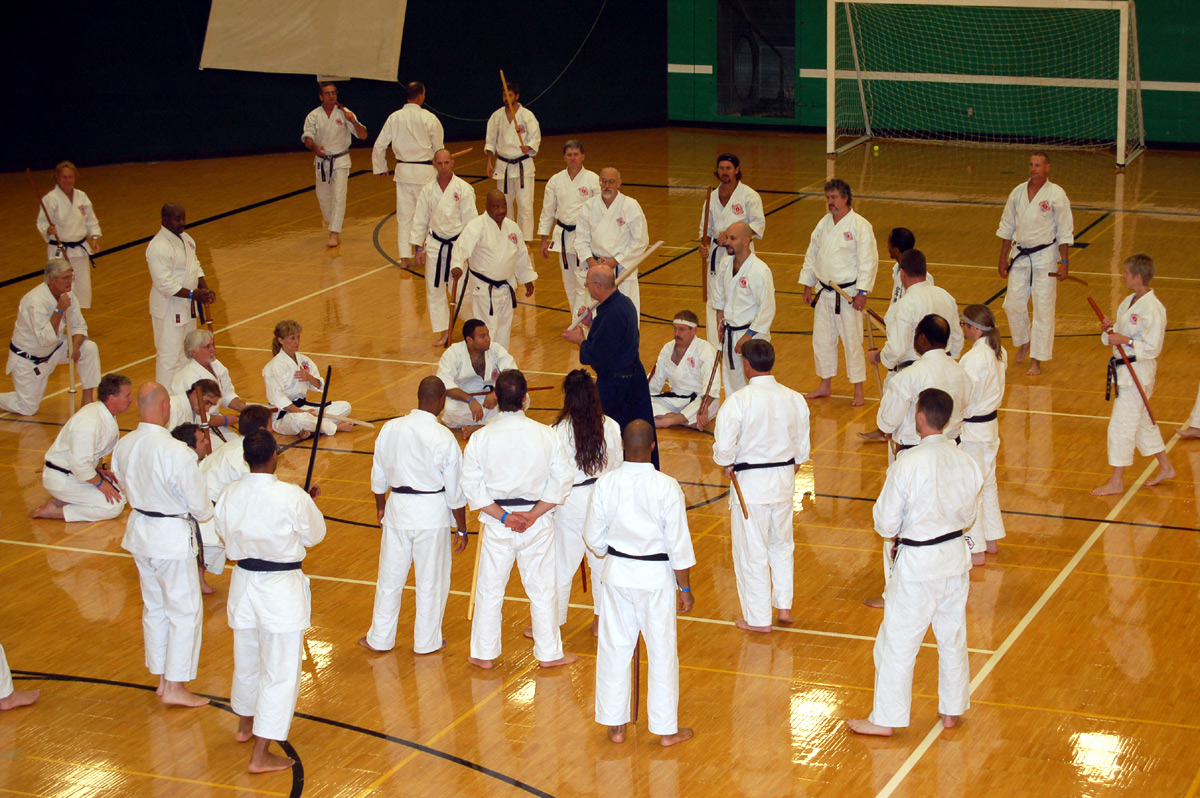
The group was divided between Yudansha (black belts) and Mudansha (kyu ranks) . Dometrich Hanshi and Hawkins Kyoshi taught Chito-ryu basics, this year stressing the quick foot work and turns that are unique to Chito-ryu karate.
Seisan-dachi and in particular on-line (chokusen) seisan-dachi were reviewed and drilled for this purpose. Hanshi continued his mantra from the recent DNBK event in Canada “sweat, sweat, and sweat”.
Mr. Lowry is a kenjutsu-ka of the Shinkage ryu lineage founded by Munenori Yagyu. This year he had the unenviable task of introducing a bunch of neophyte kenjutsu-ka wannabes to the art of the Japanese wooden sword (bokken). He began
with a short history of the sword and it’s significance in Japan. Interestingly, the bokken was not just a practice instrument, it had very real (and very deadly) applications in battle. Most of us are familiar with the
exploits of Musashi Miyamoto and his wooden sword, but he was not the only one the effectively wield the bokken in battle. There is a saying that it takes at least 3 years to learn how to properly hold the sword, for our purposes we
only had a couple of hours. And in that precious little time Mr. Lowry was able to show us not only how to hold the sword, but also drill us on a variety of strikes and exercises.
While the juxtaposition of Karate and Kenjutsu was obvious, so too were the similarities. Control and discipline are the universal hallmarks of budo. Minor (or even major) difference in foot and hand position belie the underlying
ubiquitous use of Koshi (proper use of body or hips), Kime (focus), Chakugan (focus of eyes) and Tyakugan (target awareness).
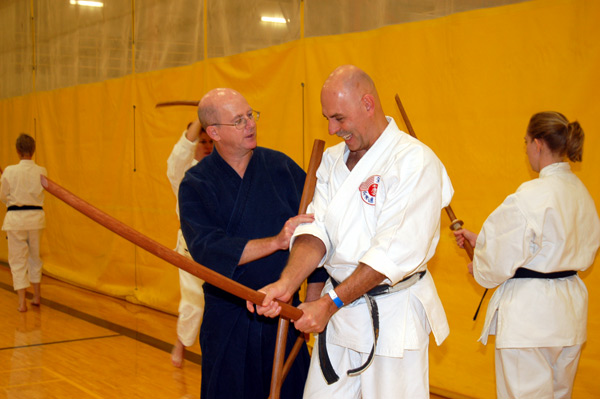
That evening we reconvened for the annual banquet and awards ceremony. Kembre Renshi reviewed the 2006 DNBK Canadian Rensei Takai. We acknowledged Wes, Eric, and Alex Ernest’s accomplishments at the 2006 World Traditional Karate
Tournament in Italy. They in turn acknowledged all the support from the USCK. Eric his Gold Medal to Hanshi as a token of his appreciation. In turn, Joe Williams Shihan of the WTKA asked Hanshi permission to have Eric coach the team
again next year.
In recognition of his dedication and contribution to the USCK Dr. Willie Elliot was awarded the title of Shihan.
USCK Chairman Hawkins Kyoshi spoke to the group regarding risk management in the marketplace. Referring to a recent action brought in New York against a Karate school and it’s instructors, Kyoshi discussed the the potential for
similar circumstances within the USCK. As responsible teachers and business people it is incumbent upon us to practice “self defense” and be prepared.
Mr. Lowry elaborated on his choice of sama as the theme for this years clinic. Sama is translated as “content of style” or in other words “style with substance, form with function”.
Sama is what all individual bugeisha should aspire to achieve and what the US Chito-kai as an organization should strive to preserve.
With over 100 attending the clinic and banquet, 2006 is another in a long line of successful seminars for the USCK.
October 2006 Banquet
By: Sherry Lynn Kembre, Renshi
The evening of October 28th proved to be a relaxing and enjoyable night. After four hours of intense and informative training the karate-ka from all over the United States and Nova Scotia and their families were able to be present
the annual Chito-kai banquet.
The banquet began with the invocation given by Dr. Jesse Brown of Rochester, New York, who recently was promoted to go-dan. The meal consisted of fish and roast beef that was delicious and left many of the young members wanting
more.
The presentation of awards and rank was followed by the year in review with an outstanding power point presentation of many photos highlighting this past year. Especially highlighting many of the visits of branch dojos and the
opening of new schools, such as Mark Chisenhall’s school Yoseikan Napoleon Kentucky and Anderson Yoseikan owned by Shawna and Mark Lingo. Jamie Binkley, Yoseikan Of Orlando III, and Todd Dugan, Yoseikan of Illinois.
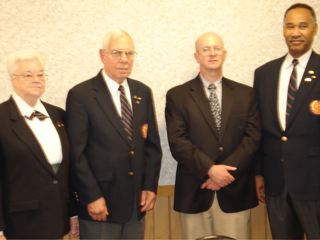 A few special awards were given, such as the gold medal won by Eric Ernst from his world championship win in kata to Hanshi. Eric and his brother Alec and father, Wes, traveled to Italy in September for the
competition. The Ernst family showed off the beautiful championship trophy. Many members of the Chito-kai pitched in to help cover the expenses and the Ernst family wanted to thank everyone for this opportunity and to show their
winnings.
A few special awards were given, such as the gold medal won by Eric Ernst from his world championship win in kata to Hanshi. Eric and his brother Alec and father, Wes, traveled to Italy in September for the
competition. The Ernst family showed off the beautiful championship trophy. Many members of the Chito-kai pitched in to help cover the expenses and the Ernst family wanted to thank everyone for this opportunity and to show their
winnings.
Another presentation was a handmade boken presented to Don Schmidt. The boken was made by Mike Schaefer from a piece of wood that Don had found. Mike has made many boken and often has them for sale; however this boken is especially
different. Not only is it beautifully crafted it was made especially from a branch of Hanshi’s tree.
This past summer many members of the Hombu replaced the main training deck with bamboo. The crest that once was in the center of the floor has special meaning. The deck is the same deck that O’Sensei demonstrated and taught
classes on, so we could not cover up the Chito-kai crest. Mike Schaefer once again worked his wood magic and cut out the crest without Hanshi knowing it. Not letting Hanshi know was not an easy task, a lot of redirection of his
attention was needed. The crest was cut out and framed and presented to Hanshi at the banquet. It was the highlight of the night. There are only a few schools in the United States or in the world that can say that O’Sensei
actually taught and demonstrated on their floor.
The evening ended with a few door prizes being presented and following the banquet many of the participants headed to the Comfort Suits party room for socializing and in some cases practicing kata in the hall. No one wanted the
weekend to come to a close. October is a special time of year for the U.S. Chito-kai; it is as time for celebrating O’Sensei’s birthday, a time for training and a family reunion of the U.S. Chito-kai family.
Wabi Sabi
By: Nazanin Tork, Yoseikan II, Cincinnati, OH
As I was preparing myself both physically and mentally for my first National Kangeiko, I was still unsure of the expectations and requirements of this traditional winter training. The one thing I was certain of was that I would gain
valuable experience and insight from the intensive training in the unfavorable conditions.

This year’s Kangeiko was attended by karate-ka from different schools with various levels of experience and age. We gathered around a nice dinner the night before training (courtesy of Okusan and Kathy), becoming acquainted
with our traveling brothers and sisters, exchanging humorous tales and receiving some words of wisdom about winter training. As has become a tradition, Shihan Khalily spoke to us on deck about our time together and toasted each of
us in turn with sake or mizu. By 10 o’clock the lights were out and we slept in the brisk cold, some with our gi’s on, anxiously awaiting the moments to come.
Wabi Sabi, translated as “the beauty of impermanence”, was the theme of this year's Kangeiko. We started off with warm-up exercises with Sensei Mike Messinger. We completed hundreds and hundreds of punches and kicks.
After a couple rounds of push ups, the count was perfect every time. We worked on various kata, including a new one for me – Ananko, but we concentrated on Sanchin kata and worked on using the lowest stomach muscles to power
our techniques. Going over several application ideas gave the kata new life. Not to mention, what better time to go over all 28 Henshuho several times. The instructors of Kangeiko covered a wide array of techniques incorporating
both creativity and effectiveness in their teaching methods, which proved successful especially when the time had come to do the traditional outdoor barefoot run a bit after sunrise. Now it wasn’t mandatory to run barefoot,
but since the moment was ‘impermanent” I couldn’t imagine doing it any other way. Training concluded with a warm cup of green tea, which was very relaxing.
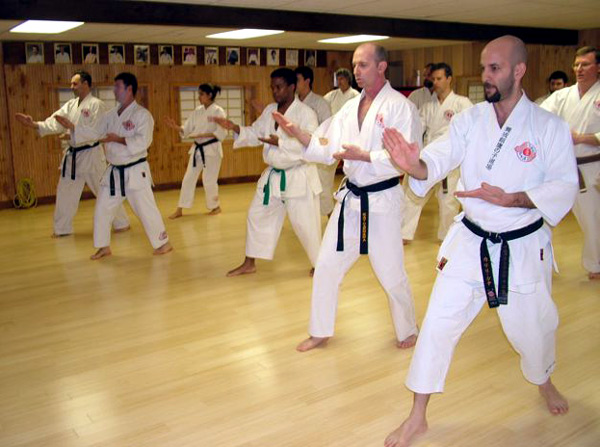
We knew this time together and our journey was coming to an end soon only from the smell of breakfast cooking (courtesy of Okusan and Kathy). As we performed Sanchin one last time, we enjoyed a surge of new energy running through our
minds and bodies. Kangeiko had in fact an invigorating affect on our physical and mental states. We had undergone a training that honed our fighting spirit and allowed us to purify the mind, overcome hardships and enjoy the moments
– each one fleeting and beautiful in its impermanence.
March 17th, A Birthday Party to Remember in Chito-ryu
By Jamie Binkley, Yoseikan III Orlando
On March 17th, 2007, the annual USCK karate seminar and dinner were held in honor of Hanshi William Dometrich's birthday. The seminar was held at Northern Kentucky University, where we are fortunate to have access to
a spacious venue every year thanks to Shihan Willie Elliott being a professor at NKU. Over 87 karate-ka and guests gathered in the Regents Hall gymnasium to participate.
Class began with warm ups conducted by a fellow budoka Kamau Akil Chukwueneka, a Gojo-Ryu stylist and DNBK member. We warmed up further with renzoku waza, moving up and down the deck. After basic
warm-ups concluded, the class was split up with Renshi Jerry Beshears and Sensei Don Schmidt teaching the white through green belt adults, and the kids working with Renshi Jim Matthews, Sensei Connie Kramer and Sensei
Cindy (Webster) Roszell. Seeing Renshi Matthews teaching again was also a treat. Recovering from serious injuries due to a car accident, he has finally been able to train and teach in his new location in
North Carolina. Before the seminar, he had a gaggle of kids around him, already conducting a mini-seminar. If you want to find Renshi Matthews, just look for a crowd of kids surrounding a big strong guy with a
heart of gold. Yes, he’s healing up and back to his old self!

Renshi Beshears had his class working on moving their center and feeling how to generate power from the center. In speaking with some of our Florida mudansha who have just started karate training, what stood out for
them was the idea of working on hips to punch, keeping the elbows in and the stomach tight, great concepts for any belt level. Another student was impressed with the kicking - being only their second ever karate
class he was thrilled by it all.
The brown and black belts were instructed by Hanshi Dometrich; with assistance from Kyoshi Hawkins and Shihan Khalily. The advanced belt class worked on kicks; using the kicking sequence from Kihon Kata
Ni (front, side, round and back kicks). Then we paired up with a partner to help focus these kicks on proper target area, and continued kicking deck drills in this manner, all the while Hanshi challenging us to
do better, to keep better balance, better target awareness and use more speed. We then worked Seisan kata with Hanshi giving a lot of teaching points during the session. As this is our signature kata in
Chito-ryu, it is always good to take away points of refinement. Each of us internalize the instruction a bit differently, but for me, some key points were keeping straight posture, making sure seisan stance has
proper distancing, and keeping body offsets correct (don’t over-rotate for example). Lots of other teaching points were shared, but I won’t list all of them, come to the next clinic and experience them
for yourself!
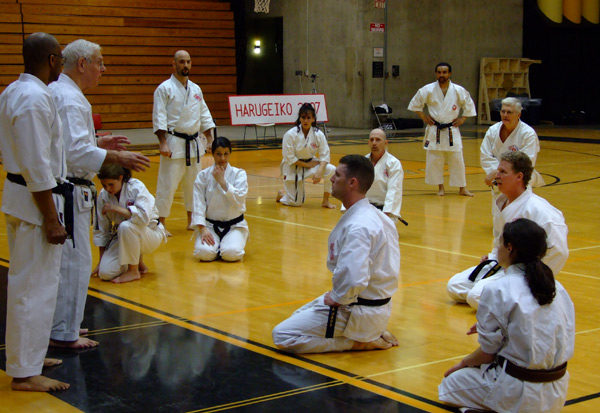
Next came the class segment focused on fighting techniques, first using different stepping movements to effect speed and distancing. This was a great drill to practice moving in on an opponent while delivering
kicking techniques (building on the earlier kicking segment). We then expanded that to practicing counter techniques as our partners attacked. Of course no Chito-ryu advanced class would be complete
without some dachi-no-waza drills. Special emphasis in the instruction was placed on precision of stances, including posture, how the weight is distributed, and the position of our feet and the offset of our bodies.
After four hours of great training, the seminar was concluded with our traditional group photo. As we all huddled together, I couldn’t help but notice how many mudansha and kids we had at the seminar.
With several new schools having opened in the past year sending students, as well as strong attendance from the core schools in the area, our next generation of Chito-ryu attendees were numerous, and their opportunities to
learn from great teachers endless.
Afterwards there was a terrific potluck dinner that included mass quantities of food. Kyoshi Dwight Holley and his wife and one of his students attended, as well as Kamau from the clinic. Attending one of
these events is always a bit like a class reunion, with visits from some of those students who are no longer training coming to pay their respects to Hanshi. Following the dinner, everyone gathered around Hanshi
to watch him open presents. It was a wonderful way for the USCK family to pay tribute to this amazing man.
No matter how many times I visit the hombu, I always take time to walk around and look at all the pictures. The history contained on the walls of the hombu is rich and unique, documenting a man and his
family who made history by bringing Japanese/Okinawan martial arts back to the United States. And while we never want to find a picture of ourselves with an 80’s mullet hairdo (present company included),
it’s always great to see the people and events throughout USCK history that have helped shape our art and our organization.
See you in October for the next big birthday party, O’Sensei’s!
S H O C H U G E I K O 2 0 0 7
By: Don Schmidt, Hombu Dojo
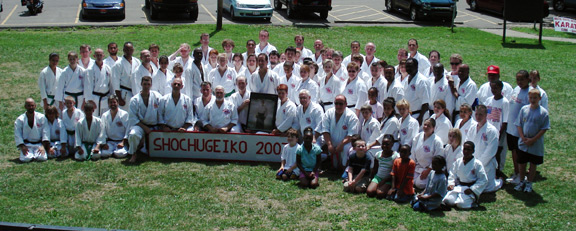
An auspicious moment occurred at the beginning of our Shochugeiko 2007. Immediately after the tranquil practice of bowing in, a family of red-tailed hawks espied our warm-up session and made quite a ruckus as
they soared directly overhead in the glistening sunshine. Their “spirit yells” filled the training field on this beauteous Saturday morn. The younger hawks were being fed by a parent and being taught survival techniques and
skills. The irony is that on the ground karateka were preparing to learn from their sempai methods to improve their techniques and skills in martial arts.
Hanshi Peter Brockers, President of the International Karate Federation-Germany hombu, was our special guest. He is a student of Kanazawa Sensei of Shotokan fame. Brockers Sensei visited the hombu on the previous Thursday and ran a
spirited hour of training. Brockers Sensei taught the Shochugeiko group some of his kihon kata that involve partners and the principles of sen, go no sen. Briefly, Brockers Sensei starts his kihon kata with an attacker performing san
ren tsuki and the initial kata involves the defender blocking the head and chest punches, and then becomes the attacker. Role reversals between the attacker and defender occur that ultimately result in one punch, certain defeat.
Brockers Sensei has an entire series of these partner kata that involve more advance techniques.

Sensei Byers and Khalily warmed-up the entire group before we separated into different groups by rank. Khalily Sensei reviewed with the black belts Tenshin kata because those going to Japan in April 2008 for the
DNBK event need to know this kata. Beshears Sensei worked with green belts, Byers Sensei worked with brown belts, and Kembre Sensei worked with 7th, 8th and 9th kyu belts.
During the final hours of training, Ford Sensei gave the brown belts a thorough review of Sakugawa no Kon Sho which included bunkai . The bunkai involves partners moving to and fro applying different strikes and blocks that are
present in the bo kata. Green belts and black belts remained together and were taught a good dosage of the Henshu Ho. Adult 7th, 8th and 9th kyu belts were being taught by Elliott Sensei and Hayes Sensei. The children were given a break
in their training about two hours after the fun started.
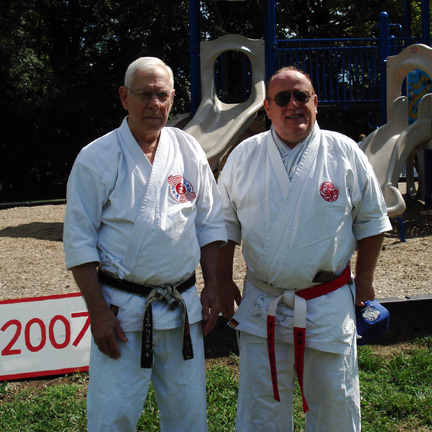
While the physical training was coming to an end grill master Kathy Webster was stoking the fire with the help of Banks Sensei and perhaps others to have the food ready for consumption. The picnic’s
success hinges on everyone pitching in by bringing a covered dish and assisting in the set up or cleaning up afterwards. Once again, everyone seemingly had a great time. It is always nice to train with and exchange conversation with
others in the organization from other dojo.
Hanshi and Okusan invited, Brockers Sensei to their house where karateka gathered to continue socializing. Brockers Sensei is already talking about returning in 2008.
U.S. Chito-ryu Karateka Go Head over Heels for Sensei David Akutagawa
By: John F. Wellbrock
On Saturday the 20th of October the U.S.Chito Kai held their annual fall seminar at Northern Kentucky University as part of their 40th anniversary celebration. Having two of the most significant Chito-ryu karate disciples
in North America, Hanshi William Dometrich & Shihan David Akutagawa, made this seminar extra meaningful for all those present.
After formal bowing in and a brief warm up period Sensei Akutagawa took over the Yudansha, Black Belt Division for a most invigorating afternoon. The training started off with although Sensei Akutagawa thought that the mats
at N.K.U. were a little too thick for proper footwork, most karateka were grateful for the extra padding by the end of the day. Sensei was very impressive with the speed and agility with which he demonstrated all of the techniques. It
was impossible not to adopt his enthusiastic attitude toward the training and in relatively short order the entire class was going head over heels.

Sensei Akutagawa moved on with an in depth study of the kata, Sanshiru. First he talked about the aspects of kata; the movements or techniques, the bunkai, the rhythm, and finally the art the kata. He said that although
Doctor Chitose’s Chito-ryu katas were shorter in length than many other styles of karate, he felt that the Chito-ryu kata were extremely sophisticated. Sensei said that our Seisan kata was probably one of the most complete katas
when it came to displaying what Chito-ryu karate was all about. He also noted that the many open hand techniques of the higher level katas were hallmarks of Doctor Chitose and his kata.
Working his way though Sanshiru, Sensei Akutagawa demonstrated numerous applications for each of the movement sequences. Sensei used many of the movements as entering techniques to be followed by a throw or a takedown.
The training give the karateka ample opportunity to practice the break falls and rolls that they warmed up with earlier in the day. As if Sensei’s technique wasn’t already enough to completely discourage his opponent, he
ended each series with some type of finishing technique designed to either control or disable them. He demonstrated a wide variety of strikes, chokes, arm bars, joint locks and numerous painful manipulations of the human body to the
delight or dismay of many of the Black Belts.
After taking a post seminar poll, perhaps “Akutagawa“ should be pronounced “ Ouch-I-got-ya”.
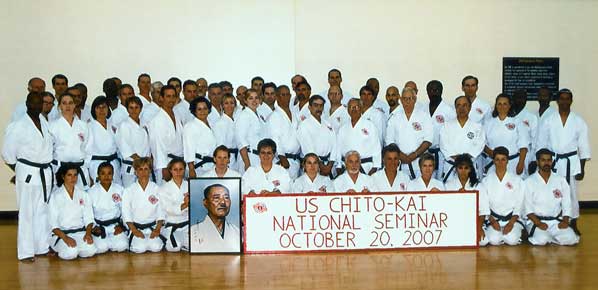
In addition to the Saturday seminar, Sensei Akutagawa was most generous with his time over the rest of the weekend. On Friday evening he sat with the National Test Board for the Black Belt test, which lasted several
hours. Despite running late into the evening , he took the time to address each test candidate and gave everyone positive criticism and encouragement. Saturday evening was spent at the banquet, and Sunday Sensei held and extra training
session for the upper ranked instructors.
One would be at a lost to describe Sensei Akutagawa with just a few words, but some the following come to mind: inspirational, motivational, budo spirit, excellent technique, and the open minded attitude of the great jazz
improve saxophonist Art Pepper, (you had to be there). Finally, it goes without saying that this was one great Chito-ryu karate weekend. Thank you a thousand times to Sensei Akutagawa for sharing your time, your knowledge, and
especially special personality. Bonzai ! Bonzai! Bonzai!
EXPOSURE
by Don Schmidt
Hanshi and Okusan have done it again! They invited their good friend Sensei Akutagawa to be the special guest instructor for the 2007 celebration of O-Sensei’s birthday. During the weekend, we had the opportunity
to train with Sensei Akutagawa who spent many years with O-Sensei and lived in Canada to help spread Chito-Ryu. In recent years he has been involved with Shito-Ryu. Not only did we have the privilege of training with Sensei Akutagawa
during the clinic on Saturday, Sensei Akutagawa made himself available on Sunday at the hombu to continue learning about Chito-Ryu karate and technique. What a perfect opportunity we had on Sunday to train along side a Japanese disciple
of O-Sensei who speaks English and is able to convey to us more insight about O-Sensei and about the martial arts we choose to study. Hanshi and Okusan invited Sensei Akutagawa so that we can learn as much as we can.
Hanshi, Sensei Hawkins, Mathews, Beshears, Kembre, Colling, Elliott, Ludwig, Collis, Johnson, DiTerlizzi, and I did not squander a second opportunity to train with Sensei Akutagawa. Sensei Akutagawa does not consider
himself to be a teacher. Rather, he is a student because he is learning also when he expresses to other students his views on the application of technique. Just another example of keeping the beginner’s mind! Sensei Akutagawa’s
kicks and technique were amazing for an elderly gentleman. Hopefully, his secret is karate training! The reality is that it takes some luck to make it to the upper years of life without some sort of medical infliction or other calamity.
Unfortunately, I am not going to be able to express the details of all that was covered during this three hour training session.
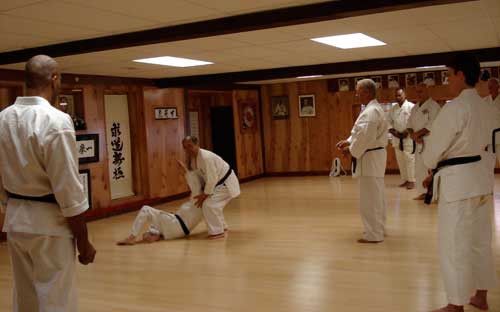
I could write a lot just about hip snap because we explored this concept, but it is difficult to write about a feeling without being too verbose. Taking a proper stance and performing proper hip snap, not to be confused
with hip rotation or hip thrust, involves a feeling that only you can experience by training. We listen to our sempai who attempt to describe the concepts of hip snap by emphasizing proper stance, contraction or compression or
tightening of core body mass, contraction of other body muscle, proper posture, breathing, relaxation, et al. On August 14, 2005, at Audra in West Virginia Hanshi sat us down under the big oak tree and told us that it is not hip
vibration, but hip snap to execute a punch or other technique while performing Chito-Ryu karate. Hanshi told us to refer to it as hip snap, not vibration. When we begin learning hip snap at the 6th kyu level the hips tend to “wiggle”.
Excessive wiggle detracts from your body connection so as you continue training try and reduce the wiggle to a compact hip snap. Sensei Akutagawa's “furigoshi” explanation, a word that is referenced in the fall 2007
newsletter, was demonstrated in his execution of a punch. His technique was a compact movement and not exaggerated to the point that his hips were moving to the rhythm of Chubby Checker’s famous The Twist. Hanshi’s hip snap
is a compact movement as he demonstrated during the session. Other components about hip snap were discussed, but judging by the size of this paragraph I may be getting too wordy. In short, keep training with a beginner’s mind.
You know ju-ji uke? Everyone should who has learned Rohai kata. It is the block/strike, cross-armed technique Hanshi keeps emphasizing is done with the right fist “palm up”. This technique is present in
Rohai-second move, Chinto kata-moves 8, 11 and 12, Sochin kata-move 25, and finally Sanshiryu kata-move 28. The written descriptions following the pictorial explanation of the kata in our manuals states that the move is a “ju-ji
uke” which Sensei Akutagawa emphasized is unique to Chito-Ryu. He said that other styles do not do the ju-ji uke, but rather a cross arm block called kosa-uke.
Sensei Akutagawa also talked about uchi hachiji dachi and how to improve this basic stance. Again, another feeling you can only experience by training. It may also help to have that magical strand of hair as Sensei
Akutagawa mentioned. Hair or no hair, listen to your sempai about correct posture and it will help your karate.
Perhaps you are familiar with the term yo-ryu-bi. Sensei Akutagawa explained that the concepts of yoryubi is important for martial arts. Yo meaning the necessity and the center of the being, ryu meaning flow as in the
flow of the movement and bi meaning beauty. Yoryubi is the basic tenets of any martial arts i.e. jiu jutsu, karate, kendo, kyudo, et al. He further mentioned that the bushido ideal and principles are in all martial arts. In the 1970’s
Hanshi always said “have good bushido”.
Taisabaki drills were also practiced and I noticed that one particular movement reminded me of my introduction to Tai Chi Chuan when Sensei Lau was a special guest instructor. Sensei Akutagawa called it neko ashi as he
combined this movement with suri ashi, yori ashi, chidori ashi to demonstrate side stepping and entering. His movement was very flowing and beautiful.
Sensei Akutagawa demonstrated a kick drill that he referred to as “happo (eight directions) geri (kick)”. Using the right leg, it starts with (1) hiza geri, (2) ushiro geri fumikomi, (3) agi ushiro kakato geri
kintama (kin), (4) mae geri haisoku kin, (5) mae geri kiagi chudan, (6) yoko geri to the right, (7) yoko geri fumikomi 45 degrees to right, (8) yoko geri fumikomi 45 degrees to the left. Most of these terms are in your manuals or easily
translatable. The third and fourth kicks may have you searching a little further.
Hanshi and Okusan have exposed us to quality and compassionate martial arts practitioners. Prepare a list of special guests and I am sure you will agree that we are fortunate to have the opportunities we have had.
U.S. CHITO-RYU OCTOBER SEMINAR WEEKEND 2007
Good Times
By Mina K. Ludwig
On the morning of October 20, 2007, two days after O Sensei’s 109th birthday, members of the USCK Board of Directors, dojo heads and shihan kai met to discuss the progress and the potential of the USCK. The overall
tone was one of success and hope.
Hanshi was pleased to report that, since 2004, our organization has grown by 30%. Chairman Hawkins urged us all to think beyond what we think is possible in terms of future growth and development. As proof and motivation, he sagely
pointed out that in the “Bruce Lee Hey Day” of the 70’s, Hanshi did not have a cadre of black belts at his disposal. Yet and still, the USCK had 1,000 members. With the depth and breadth of experience and the sheer
number of skilled black belts in the organization, we can and should be able to exceed 1,000 members while still maintaining and even improving the outstanding standards of training and traditional martial spirit.
Vice Chair, Sherry Kembre discussed mission and vision statements of the USCK which coincide the goal of growth and cultivation of O-Sensei’s legacy. Members of the organization are encouraged to maintain communication and
share ideas of success.
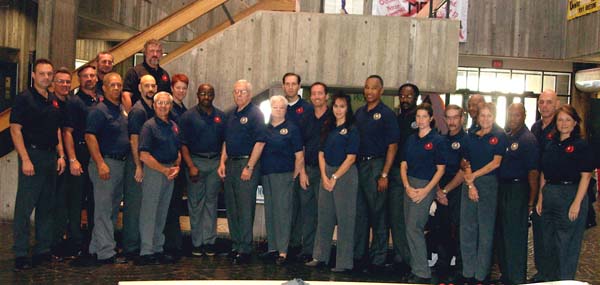
Dr. Laura Stith (AKA Deck) joined the meeting to discuss the challenge and hope for the future which lies with our children. Recently featured on local news channels as an expert in child and adolescent psychology, Dr. Stith was
able to explain the various stages of developmental growth. This shed considerable light on what children are capable of mentally and physically in each of the age specific stages. She reinforced the importance of educating ourselves
about our students in order to determine the best and most effective methods of teaching. Listening to Dr. Stith brought home the fact that we now have so many skill sets at our disposal and such a growing wealth of knowledge, the
ceiling is unlimited in terms of our potential.
Hanshi spoke briefly about the modalities of future teaching resources. Watch for DVD’s and Chito-Ryu Instructional manuals. All of these tools will facilitate teaching and learning and a more uniform promulgation of
Chito-Ryu. Further, Hanshi announced a new National Chief Instructor, Beshears Sensei, who with Hanshi’s approval, chose Khalily Sensei as his Deputy. They serve at the leisure of the Technical Director – Hanshi.
Co-founder and Chief Administrator, Kyoshi Dometrich, encouraged the group to be diligent in communication. The three primary modalities for communicating beyond participating in the national events and black belt class, are
monthly reports, emails and newspaper contributions. Let’s all strive to make our Chief Administrator’s job easier and more enjoyable.
The meeting adjourned on a high note which was sustained through four hours of training and culminated in the annual USCK banquet. The theme of the Banquet was the 40th anniversary of the USCK. In his infamous visit in to the
States in 1967, O-Sensei charged Hanshi and Okusan with the duty of establishing the USCK. He renamed the soon to be Hombu dojo, ‘Yoseikan’, to mirror the name of his own dojo in Japan. No doubt, O-Sensei would be pleased
with what the co founders have done and with their steadfast loyalty to his legacy.
A great and plentiful meal was enjoyed by all, after which we were treated to a keynote speaker as well as a photo presentation of the USCK history. Sensei Aktugawa was in his speech just as he was in this teaching and everyday
demeanor. His kindness and generous spirit were bountiful. His love and respect for O Sensei and for Hanshi were manifest throughout his talk. What I found most touching was Aktugawa sensei’s anecdotes and recollections of how
much O Sensei loved Hanshi Dometrich. It was bitter sweet to hear about the depth of affection that Dr. Chitose felt for his American student. Aktugawa Sensei reported that, during his annual visits to Japan, O Sensei spoke often and
with great pride regarding Hanshi and the USCK.
I was profoundly grateful that Aktugawa sensei shared those recollections with us. His words and reverent tone buoyed my already sky high spirit. If you were looking for some affirmation, that was it. Dr. Chitose did not just pick
some Yankee to teach Chito-Ryu in the States, then cross his fingers and hope for the best. He saw in his student what the student could not see in himself. He entrusted Hanshi with his legacy and was later, Aktugawa sensei tells us,
full of pride and downright boastful of Hanshi’s accomplishments. To be associated with and taught by the direct, beloved, respected and hand picked link to progenitor of Chito-Ryu is heady brew.
We got to see some photo proof of that teacher/student relationship in Kembre Sensei’s photo presentation. There were so many great shots of O Sensei at the dining room table completing calligraphy on certificates, sitting
seiza before his American progeny, discussing karate with Hanshi in matching kimonos on the couch, training with Hanshi in the yard and in the dojo, smiling with the family and with students. Together with Kembre Sensei’s
recollections, this made for a great end cap to the journey down memory lane.
The evening ended with awards of rank as well as national and local awards from Hanshi and Okusan: Sho Dan – Emma Gage, Lauren Fuller, Reggie Corbett, Michael Shaefer, Karen Ruperto, Suzanne Schlegel; San Dan – Mark
Lingo, Regina Rossini; Yon Dan – James Acampora; Go Dan – Warren Pochinski.
National Awards:
Yu (Valor) awards in gratitude for military service to our country in the spirit of
Chito-Ryu to Steve Nassano, David Hewitt and William Jansak (come home and eat some turkey Bill!!)
Excellence – Steve Wilhelm and Eric Ford
Outstanding Dedication, Spirit, Honor – Mina K. Ludwig
Humanitarian – Wesley Ernest
Special effort – Kevin Drummond and James Acampora
Special service – Cyna Khalily, Willie Elliott and John Wellbrock
Hombu Local Awards:
Uchi Deshi – Don Schmidt
Special Dojo Service – Joseph Petty and Michael Schaefer
Per Okusan’s request, somewhere in medias res (‘In the middle of things’ – a little Latin for my Sensei’s pleasure) and in order to score a seat at the grown up table, I had the honor of
reviewing the highlights of 2007. In case you missed it, um, apparently I thought every one of the events in 2007 was ‘a really good time.’ Truth, however, is an absolute defense to redundancy. I really did have a really
great time at every one of the 2007 USCK events. But 2008 will hold even better times. See you there and we’ll prove it together.
KYOTO 2008
DOMETRICH HANSHI PROMOTED
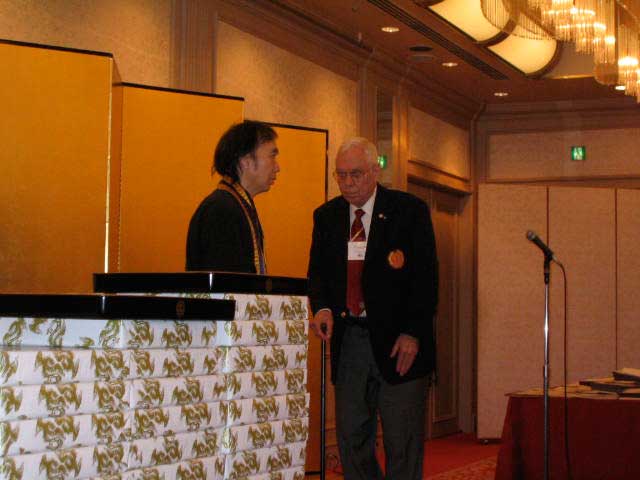
In April 2008, members of the Midwest Division of the Dai Nippon Butoku Kai travelled to Kyoto, Japan to participate in the Third World Butokusai. This was a tremendous undertaking by the DNBK Hombu and International
Division and more details will follow on chito-ryu.com and the Karate-do Newsletter. In a historic and unprecedented event, in a private ceremony following the event,William J. Dometrich, Hanshi, was promoted to the rank of Ku Dan (9th
Degree Black Belt) by the DNBK. The presentation was made by the International Division Chair and vice-Sosai. Ku Dan in the DNBK is a rare enough honor, but even more significant is that fact that
Dometrich Hanshi is the
first and only non-Japanese member
ever to be awarded the rank. Dometrich Hanshi has said that most important is not that he was awarded the rank, but that it was a direct student of O-Sensei Chitose Tsuyoshi. Anything he achieves personally is a reflection on
his teacher and Chito-ryu Karate, and for Dometrich Hanshi that's what it is all about.
More details about the World Butokusai to follow.
Japan April 24 –May3, 2008
Highlights & Memories
By: Barbara E. Dometrich
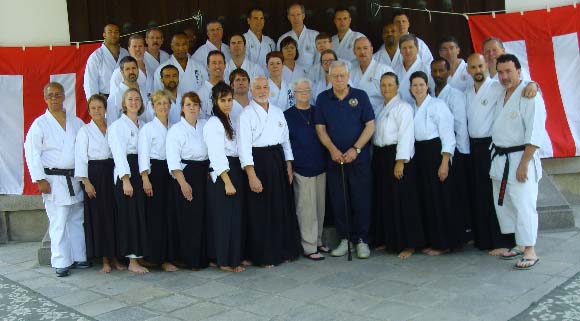
After nearly a year and a half of planning, we were on our way, 35 members and three companions from the Midwest division of the DNBK met in Detroit Michigan for the long flight to Osaka Japan. Everyone was excited and
unaware of what was expected when we arrived at our destination. The DNBK International had a bus waiting at the Osaka airport to take us to our hotel, the Westin Miyako in Kyoto, which would be home for the most of us for the next two
weeks. After checking into our rooms, it was late at night; a few members went to seek food and drink, while others fell into bed, to be ready for the long day ahead
We were given breakfast vouchers and all members were standing tall at 6:30am. Breakfast at the Miyako was the best meal of the day; it included Japanese, and western style cuisine. Directly after breakfast it was time to
walk the two miles to the famed Butokuden for orientation. At our hotel Kyoshi Bloom from San Francisco was assigned to coordinate our group, along with Renshi Kembre and in Hanshi’s absence Kyoshi Hawkins.
Each day leading up to the World Butokusai was spent enjoying breakfast, walking to the Butokuden, orientation, pre-training, and seminars. Finally the big day arrived. The day started with a ceremony at the Heian Shrine.
The first day of demonstrations was the Japanese Butokusai. There were demonstrations of Karate-do, Iai, Kendo, Jujitsu, Aikido, and more. It was a very long day, but very enlightening as each group walked onto the floor of the
Butokuden, where many past masters of Martial Arts had performed. It was an honor to be allowed to sit in the Butokuden and observe these performers. The Midwest team performed their demonstration with traditional elegance. The closing
ceremony Osami no Gi was demonstrated by Hanshi Dometrich, Hanshi Kazuhiko Kumi, Iai of Japan and Hanshi Allan Tattersall Jujitsu, from England. Hanshi Dometrich had been very ill through out the previous days leading up to the
demonstration. He had walking pneumonia and the medications were not working, with his Parkinson’s meds. He walked out on the floor with a cane and gave it to Sherry, his daughter, and proceeded to demonstrate Sai-San, his
favorite kata. When it was over there was a standing ovation, cheers and tears. Hanshi was bewildered, didn’t know why they were standing for him. You had to be there it was very emotional.
The following day was the International Butokusai. Many demonstrations from 40 countries. There were approximately 650 International members demonstrating. Each demonstration built up the excitement for the next. The Midwest
division once again demonstrated with grace and precision. The Midwest division was divided into two waves. One was all Chito-ryu participants and the other consisted of Shotokan, Goju-ryu and Shito-ryu. Considering most of our
participants came from different locations and had not trained together until rehearsals in Japan, they all pulled together and did an excellent presentation.
The last evening was the final banquet, after eating an eight-course meal and hearing many speeches, awards and gift giving, and many photos being taken, to solidify new and old friendships. Hanshi and I were asked to wait and meet in another
meeting room (our daughter Sherry went with us). The rest of the Midwest Division continued back to the Miyako. It had been a very long day for Hanshi, and he was not feeling well. We went to the room set up
for the meeting, actually what took place was certifications for promotions, Hanshi Dometrich was called up first and it was announced that the Dai Nippon Butokukai was promoting him to KyuDan (9th degree black belt). He is the
first non-Japanese martial artist to ever receive this promotion. Hanshi was as stunned as Sherry and I with this announcement. That was a very memorable part of the trip for us. As Hanshi and I realized because of his health issues and
our age that this would most likely be the last Butokusai that we would attend in Japan. We do look forward to other functions in the future closer to home.
The last three days in Kyoto were spent sightseeing, shopping, and seeking out the local restaurants for evening meals to get the flavor of Japanese culture. While there we were able to visit with our ex-son in-law Ken
Sakamoto and Akinori Kuzuhara very good friend who lived with Hanshi and me for six months in the late 70’s.
There are many things to write about regarding this memorable trip, it would turn into a book if we wrote it all, so I have asked all the participants in the Midwest group to write something that was the most memorable to
them with a couple pictures and we will publish them in the Karate-do newsletter when space allows. Who knows it may turn into a book!
Morning Homage
By Mina K. Ludwig
On the morning of October 18, 2008, the 110th anniversary of O Sensei’s birth, the USCK Board of Directors convened as it does each year in October. Comprised of shibu dojo heads and the Shihan kai, the Board
meets annually to discuss the previous year and to make plans for the future. This particular meeting was bound to be beyond the norm. Change was afoot - some scheduled, some not. It’s not often that we meet precisely on O
Sensei’s birthday. It’s not often that an old, dear friend would be buried on the same day. Certainly, it was no ordinary day.
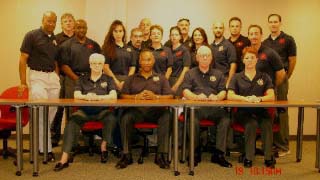
This would be the first exchange of authority of Chairmanship to Vice Chair marking the end of Kyoshi Hawkin’s second term as Chairman. Similarly, having completed his term, Chief Instructor Kyoshi Beshears was
to pass the reins to Shihan Khalily. Didn’t happen quite like that. Okay, here’s what happened:
First, in his last address to the Board as Chairman, Kyoshi Hawkins explained in succinct and clear detail the blueprint for accepting a student, retaining that student and, if necessary, bidding the student adieu.
The underlying theme was to utilize effective communication from beginning to end and all points in between. Based upon questions and commentary, this talk was extremely well received and informative to all.
Hanshi’s message was a reprise on the theme - talk to each other constructively, resolve conflict and be kind to everyone. We are bound to step on each other’s toes, just talk it out and everyone be nice.
With tensions running high with the 2008 Presidential election, Hanshi’s message was particularly poignant: If every human being disappeared tomorrow – the animal kingdom would not worry about national debt, religion,
politics, war and the like. All of it would disappear along with the complex, trouble-making minds of humans. What does that prove? Well, none of it actually exists except in our own collective minds. Now that’s deep.
So, if we make a point of always endeavoring to treat others perhaps better than they ‘deserve’ to be treated, measure by measure, bit by tiny bit, don’t we make conflict go away? Lao Tsu said,
“How do I know about the world? By what is in me.” As budoka and as representatives of the USCK, we have to be the best examples of ‘citizens of the world.’
With that, all that Hanshi wanted to do was visit the little soldier’s room. Little did he know that he and Okusan would be banned from the room while Renshi Kembre, newly anointed Chairwoman had hatched a plot.
In a nutshell, she explained how all of us are bricks in the wall, the foundation of which is Hanshi and Okusan. She proposed we get back to the foundation by restoring Hanshi to the position of Chairman and Chief Instructor. In the
wake of Akutugawa sensei’s passing, this struck a chord in all. We had Akutugawa sensei with us just one year ago. He looked like Yoda from Attack of the Clones the way he was flipping around, over and over demonstrating ukemi
waza better than a 20 year old. No one knows what a year or even a day can bring. While I’m convinced that Hanshi will outlive us all, it is incumbent upon us to respect, enjoy and utilize him, our national treasure, to the
fullest extent possible while it is possible.
Now I have to tell you, I know personally that Kyoshi Hawkins tried more than once to abdicate his position as Chairman. Kyoshi is ever mindful and knows precisely who he takes his marching orders from. And we all
know who the boss really is (hint - you pass her office coming into the Hombu dojo). Whatever you may think about nominations, elections and free will – make no mistake that Hawkins sensei was operating under direct orders
from his teacher to act as Chairman. A clever daughter, however, knows just how to get around her father’s orders. Renshi Kembre put the matter to a vote at the Board of Director’s meeting. Though not privy to the plan,
both Kyoshi Beshears and Shihan Khalily along with the rest of the board were enthusiastic supporters. A plan for succession will be made transparent in the months and years to come. For now, we are going to live in the now.
On his 110th birthday, O Sensei received a couple gifts. Ceremonially, Akutugawa sensei was restored to his side, and Hanshi was restored at the helm of the USCK where he belongs. Omedeto gozaimasu.
ROGER PAYNE, KYOSHI VISTS USCK
Subject: MSMAS Press Release...
>
> Latest ~ Tuesday, 21 October 2008
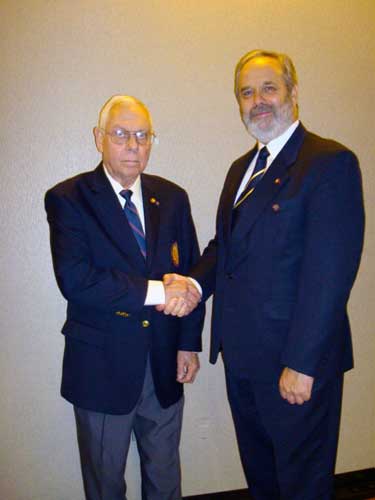
MSMAS Dojo has just returned from the USA where they have been to celebrate the 110th birthday of late Dr Tsuyoshi Chitose, Hanshi,Ju Dan, Founder of Chito-ryu Karate.
They were there as Guests of William J. Dometrich, Hanshi Ku Dan (Ninth Degree Black Belt) DNBK Certified, Founder and National Technical Director United States Chito Kai Federation to attend the United States Chito Kai
Annual Seminar, Black Belt Testing & USCK Annual Awards Banquet.
Let me say, before I start this report, that in my opinion, and those also of the Members of MSMAS already lucky enough to meet them both, that Hanshi Dometrich and his wife, Kyoshi Dometrich (a.k.a. Okusan) are, as they say
in the States, the 'real deal' ~ otherwise we would not have gone ….
It was in 1953, that Hanshi Dometrich took his first Karate instruction under the renowned Karate Teacher, Dr Tsuyoshi Chitose and today, over 55 years later, William Dometrich is STILL a student of the now ‘late Dr
Tsuyoshi Chitose’!
That is loyalty and commitment "beyond the call of duty" some might say...
However, for both Hanshi and Kyoshi Dometrich that type of behaviour comes quite naturally.
Hanshi Dometrich still works today, even though he is now in his seventies, to serve his community as a Deputy Sheriff of Boone County, Kentucky, where he lives with his wife, in their beautiful 'log cabin', set high up in
the woods, overlooked only by a simple Dojo dedicated to Dr Chitose.
Hanshi Dometrich had joined the Covington Police Department back in 1964, rising through the ranks to become Assistant Chief of Police. Over the years, he also graduated from the FBI Academy and then re-enlisted into the US
Army to become a Counter Intelligence Agent and a Member of the 11th Special Forces Detachment, serving in both Asia and Europe.
For anyone wanting to know more about their remarkable partnership, get a copy of 'The Endless Quest' (ISBN: 978-1-933901-32-9).
However, nothing can prepare you for the ‘real thing’ of just being with them and experiencing the love that surrounds them.
Members of MSMAS had set off at 0600hrs to arrive at 2030hrs in Cincinnati, after a long flight to Chicago, then another ‘very exciting storm tossed’ internal flight to Cincinnati, which, with time the changes, nearly
19 hours of travel in all.....
However, after leaving our stuff at our hotel, we were taken to a ‘magical’ Italian restaurant (the location for the film Rain Man) for dinner with Okusan (Hanshi's wife), her daughter Sherry and some of the
other USCK Members.
We were there simply to be ‘Guests of USCK’ in order to celebrate the 110th birthday of their Founder, Dr Tsuyoshi Chitose.
The next day was spent relaxing and looking around our location, Newport, Kentucky, set right alongside the mighty Ohio River, across which we could see Cincinnati, which we visited that morning. That afternoon we were
collected and taken to the Hombu Dojo, a building that simply reeks of history and training! It even looks like traditional Dojo from the outside and once inside, the desire to train takes over. The normal evening session began with
Students of all ages taking part, the oldest, nearly 70 !
On Friday, we watched the ‘Black Belt’ Karate Testing, again at Hombu Dojo, after which we went to ‘Yoseikan 2’ Dojo for USCK, set just outside Cincinnati.
We were told nothing, apart from the fact it was ‘larger’ than Hombu ~ ‘Larger’ was no quite the right word in my opinion….
This Dojo is the centre for Kyoshi Lawrence Hawkins, Jr, Chairman Emeritus of USCK. Originally, a TV Studio, you can only begin to imagine the size of everything, 2 massive Dojos, a social area, changing rooms (including
showers and sauna) exercise room, etc., etc…
However, that USCK continuing theme, despite all the facilities offered, the theme of ‘humility’…
Our final full day was spent at the ‘Annual USCKF Seminar’.
Once again, we gathered with hundreds of USCKF Members to pay respects to Dr Chitose, then to be led by Hanshi Dometrich himself in a Training Session, which belied his years.
We had of course seen this at the Hombu Dojo on the Friday with the Testing, where once again, Hanshi Dometrich had inspired his Students to even greater efforts in their training by personal example.
Then MSMAS were honoured to give a short demonstration of Kendo, as our gift to Okusan due to her own past Kendo training. Following that Kyoshi Payne was asked to lead the entire USCKF group to explain the similarities
between Chito-Ryu Karate as he saw it from our own perspective.
The USCK Annual Awards Banquet then followed. The Master of Ceremonies, Dr Willie Elliott introduced Sherry Kembre, Vice Chair of USCK who greeted everyone including Guests J Patrick Moynahan, Vice Provost of Northern
Kentucky University and his wife. A brief presentation of the DNBKID Kyoto trip was then given plus the Presentation of Certificates and Awards to some of those present. It was at this time that Kyoshi Payne was honoured to receive a
U.S. Chito-Kai plaque engraved:
‘In appreciation for your continued support of Japanese Budo’.
Then our last day, started with a very brief visit to yet another Dojo, then onto Hanshi Dometrich's own home, prior to our departure back to the UK.
Overall, another brilliant trip.
I will leave the last words to those previously expressed by the DNBK:
“Hanshi Dometrich is one of the most respected and influential Karate-do practitioners in America and the world today.”
* Responsible Travel ....
To offset the MSMAS 'carbon footprint' of this and other events, Kyoshi Payne personally secured an acre of Brazilian Rainforest
(Lat: 5.648 / Long: 61.490), thus locking in 260 tonnes of global warming CO2, equivalent to the annual carbon footprint of ten British families ....
Happy Anniversary Tsuruoka O-Sensei!
By: Don Schmidt
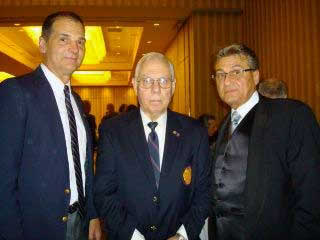
Don Schmidt, Dometrich Hanshi and Wally Slocki |
I met Wally Slocki! During the weekend of October 24, 2008, Hanshi and Okusan Dometrich and I had the pleasure of attending Masami Tsuruoka O-Sensei’s 50th anniversary celebration of teaching karate. Tsuruoka
O-Sensei’s friendship with Dometrich Sensei extends over 40 years which was evident by the fact that Hanshi and Okusan sat at the Tsuruoka family’s dinner table. Of course, Okusan and Mrs. Tsuruoka have had a lengthy
relationship. I had to chuckle as I walked into the banquet room with Okusan. Mrs. Tsuruoka greeted Okusan with hugs and as fast as we walked into the room, Mrs. Tsuruoka swept Okusan into a secret meeting in the ladies’ room. I
think they felt as if they were 16 again. The common thread between Tsuruoka O-Sensei and Dometrich Sensei is that they studied Chito-Ryu karate under Dr. Tsuyoshi Chitose O-Sensei. Dometrich Sensei refers to Tsuruoka O-Sensei as his
sempai and less formerly as the “terror of Kumamoto”. The historical significance of being at a gathering involving these two early students of Chitose O-Sensei is impressive. In 1958 Tsuruoka O-Sensei brought Chito-Ryu to
Canada and in 1955 Dometrich Sensei brought Chito-ryu to the United States.
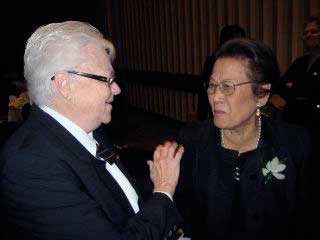
Okusan Barbara Dometrich and Okusan Kay Tsuruoka |
These two individuals are responsible for introducing Chito-Ryu karate in North America. Tsuruoka O-Sensei is the father of Canadian karate because he is credited with being the first to begin teaching karate in Canada
where he was born. Most of us in the U.S. Chito Kai have had the privilege to meet and train with Tsuruoka O-Sensei because he has been a guest of Hanshi and Okusan for many different events. His students put on a celebration that was
well deserved for this remarkable gentleman, but after listening to some “war stories” from his students they witnessed the “terror of Kumamoto” and not a gentle man during their karate training. Training “as
it once was” was reflected upon by the seniors of Tsuruoka karate and some of us recall Dometrich Sensei’s training “as it once was”. Perhaps a couple quotes to set the tone of their training regimes. Tsuruoka
O-Sensei on taking a rest: “Why rest now? You will have plenty of time to rest when you die.” Dometrich Sensei on taking a water break: “We don’t take breaks in this dojo. We die where we stand.” There were
many fond memories of the shinai and memorable training moments as mentioned by Tsuruoka O-Sensei’s senior students. His senior students were senior. At my dinner table, I sat next to a gentleman named Norman and after a brief
introduction I asked him if he still trains. Norman said “son, I am 90 years old”. Instead of facetiously saying his age is a poor excuse for not training, I quickly applied a little tai sabaki in an attempt to hide my
naiveté and told him that he looks like he is 70 which was true. The admiration Norman had for Tsuruoka O-Sensei was evident and many others bestowed numerous accolades on Tsuruoka O-Sensei for his kindness, friendship and love.
I attended the Saturday training session. Tabata Sensei taught the first session which covered kumite ideas of entering, scoring and getting out of harm’s way. Dometrich Sensei followed with an hour of Chito-Ryu basics emphasizing
shiko dachi, seisan dachi, neko achi dachi and kosa dachi.

Dometrich Hanshi and Tsuruoka Hanshi |
Tsuruoka O-Sensei taught a session which involved his ideas on how to produce a better, stronger, block and punch. We did get a rest break with water. Dometrich Sensei proudly introduced me to Wally Slocki. We have heard
and read about Slocki mostly when Hanshi recounts his story when his nose was broken during a kumite match in 1968 when he faced off against a speedy 19-year old. Yep! Wally Slocki was at the banquet and Hanshi measured Slocki’s
fist to his nose and said “yep, that’s the one that fits”. (See pages 48 and 210 of Hanshi’s book, second edition.) During the social on Friday night, I also met Spike who is referenced in the book Angry White
Pajamas. Hanshi was in the process of showing Spike what I think is Hanshi’s favorite wallet picture, paused at the pictures of his grandchildren Kira and Dylan, and then flipped to the picture of Okusan doing her side kick.
Hanshi is proud of that picture and credits the success of his organization to Okusan.
During the banquet, Mrs. Kay Tsuruoka received many thanks from the students for supporting Tsuruoka O-Sensei and they said that she is instrumental to the success of her husband’s karate organization. In the early
days, Mrs. Tsuruoka made gi’s for the students, taught classes and is a chef by the accounts given by the students. The Tsuruoka-Dometrich connection is a bond of friendship and love that goes beyond having the same karate
teacher. Different countries, same continent, same support from their spouse. The latter being probably the most single reason why these two legends in modern karate history and their wives have influenced so many karateka in North
America.
Rely on Change
By Mina K. Ludwig, Yoseikan Yoshisu
On the morning of March 14, 2009, the shihan kai and the shibu kai assembled at the Hombu dojo for a technical meeting. Ostensibly, this meeting had been intended to allow the shibu dojo instructors, particularly
those who live beyond Kentucky and Ohio, the opportunity to ask Hanshi technical questions regarding the USCK curriculum. That was the original intention anyway. But we are trained to expect and adapt to change. And
so, it was time for some training and a good dose of change.
Hanshi arrived with an agenda. His agenda was to get everyone on the same chito-ryu page. He explained his reasoning around originally incorporating standard Japanese Karate Association stances and techniques.
He explained how he had sought counsel and assistance from the best and the brightest at the time that he and Okusan were forging the USCK. As we all know, there were highly skilled Shotokan instructors who traveled and
promulgated Shotokan karate. There was and is a great deal to learn from instructors of that caliber.
Within our organization, we have developed to the point that we also have highly skilled instructors. What officially began in the late sixties as a fledgling group making its way and learning along the way, has
matured to the point that we can forge our own path. That path is designated by Hanshi. It’s the path that, in his estimation, is closest to what his teacher would have wanted and what he was striving for in
Chito-ryu.
Hanshi had the tacit agreement of O Sensei to utilize JKA type basics for the first year or so of the USCK student’s development. Hanshi believed this type of training was important to the development of
strong lower body and dropping one’s center of gravity. The top heavy Westerner needs that focus and development. It seems that O Sensei was less than thrilled, but allowed Hanshi the flexibility to teach as he deemed
appropriate and necessary. It is time now to put our greater knowledge and skill to work. The legs, the tanden and the concept of rooting to the ground – all of that still needs to be a point of emphasis. Don’t
ignore it, don’t forget it – these are still critical objectives. But we need to be able to accomplish these goals while teaching Chito-ryu stances and techniques. No more waiting until students are green belts
to show them the Chito-ryu gems. If a student joins, they get Chito-ryu.
So the sum total is that zenkutsu dachi and kokutsu dachi are no longer a part of the USCK curriculum. Instead, seisan dachi and shiko dachi, hallmark Chito-ryu stances, are to be utilized. In the
Taikyoku kata, each independent down block should be executed in an off-line shiko dachi. Where a down block is coupled with another block, as in Taikyoku san, both blocks will be executed from seisan dachi. All other blocks
and strikes will be executed from seisan dachi except that shuto uke will be executed from neko ashi dachi.
Both neko ashi dachi and shuto uke should be executed in accordance with Chito-ryu basics, i.e. neko ashi dachi is the same length as seisan dachi and shuto uke is delivered in a somewhat circular fashion from the base of
the rib cage, palm up to palm down, similar to the trajectory of the chudan soto uke except that the hands are open and the block begins with the palm up.
Advanced students can be challenged to utilize in-line seisan dachi along with tsuki kaeshi on the ‘wings’ of the taikyoku kata. Coming up or down the stem of Taikyoku ichi (or san), advanced
students can utilize the rin ten exercise for those three punches. In this way, all students will perform the same kata, but the difficulty level can be manipulated by the instructor.
We can discuss all the whys and wherefores and why nots - but that is a fairly useless exercise, and it is counterproductive to the collective. We have choices about how we will train, teach, and how we can best
achieve the objective of the collective. But we must exercise great care in being consistent and working towards the same overall goals. As you teach, be careful not be inconsistent and/or counterproductive. The ones to
suffer and get confused will be the students if and when they receive varying opinions and instruction. In other words, it is for the yudansha to absorb and adopt changes willingly, uniformly and seamlessly so that their students
and/or kohai may benefit and learn by example. In this way, we all become better karate ka in possession of better character.
If you have questions, by all means ask. First, however, you might ask yourself if the best course of action might be to simply shut up and train. There is beauty and clarity in simplicity. As Hanshi
remarked, no one ever got good at karate by talking about it…which probably means that this article is entirely too long. See you at Shochugeiko.
Train and Sweat – That Hasn’t Changed
By Mina K. Ludwig, Yoseikan Yoshisu
The 2009 USCK March clinic was a blast as always. Of course the Shibu kai and the Shihan kai had the heads up on some pretty dramatic technical changes, but whether or not the participants knew exactly what was
going on, there was one constant – good sweaty training.
Hanshi Dometrich explained again the evolution of the USCK curriculum, and how it is still evolving. For many, excluding zenkutsu dachi and kokutsu dachi from the curriculum seemed like a really big deal – and
it is going to take some significant revamping and reanalyzing for instructors to find the optimum training strategies. But in the end, as the clinic showed us, it doesn’t really matter what we do. What matters is how
we do it, and what ‘it’ does to us. Are we willing to suspend our concerns and simply train to exhaustion? The answer was, as it should be, a resounding ‘yes’.
Training at the Spring clinic began with Chito-ryu basics. Hanshi explained the natural advantages of the Chito-ryu stances. After countless renzoku waza, Hanshi began to integrate the Chito-ryu concepts into
the Taikyoku kata. We then moved on to some Chito-ryu exercise kata, again, focusing on stances and transitions. Shihan Mark Chisenhall spent some time with us going over the nuances of tsuki kaeshi, and finally, yours
truly and Sensei Matt Scott facilitated some work on Henshuho. Time flies when you’re having fun. We only covered 9-15.
There are so many different paths to follow, and everyone is convinced that theirs is the right and best path, the best art, the best ryu. If they are training hard, if they are improving and strengthening their
chosen ryu, if they are constantly learning and improving, if they are forging bonds, becoming better and kinder human beings – I say they are all right. Their art is the best. What we do must be effective,
but whether it’s this stance or that really does not matter a whole lot. As always, it’s a matter of attitude, fervent training and sheer will.
Periodically, we have opportunities to show measurable progress towards being better, more flexible and more accepting people. An obvious example is the curriculum change. Perhaps less obvious is the fact that
the USCK, as a group, invited and welcomed many guests to the clinic and after party, including Kyoshi Valentino and three of his students from the Koshinha organization. Everyone seemed to truly enjoy the opportunity to train
with old friends and fellow karate ka. Our guests enjoyed themselves and relished the opportunity to spend time with Hanshi, Okusan and the rest of the USCK crew. Banners, philosophy, names, patches, pride …. in the
scheme of life these things matter as little as what stances you are using.
As always, we rounded out the 2009 March clinic with a great pot luck birthday party for Dometrich Hanshi. This was the biggest crowd I can recall seeing and a good time (and too much food) was had by all.
With Spring under our belts, next up is summer training. Practice the changes in the curriculum so that Hanshi will be pleased with our progress. See you at Big Bone.
Butoku News
Special Occasion in Honor of Hanshi Dometrich 2009
US Edition
April 5, 2009

What makes so unique of our association is not based on just superior skills and styles of traditional Budo, but potent spirit, discipline and caring respect they have for one another. When they appeared together in honor
of Hanshi Dometrich, it was like the refreshing new life energy transforming with the misty air of spring and aroma of fresh flowers long awaited in the advent of new season.
Over 100 DNBK International Division Karatedo Yudansha gathered in Norfolk VA USA to celebrate the coveted ceremony of Kyudan rank (9th Dan) from Dai Nippon Butoku Kai which was bestowed to a great martial artist, Hanshi
William Dometrich, 73, grand master of Chito Kai USA. This unprecedented honor was awarded in Kyoto last year after the Third World Butoku Sai and later rectified by the board of Hanshi in Hombu Dai Nippon Butoku Kai (circa 1895). He
became the first Karatedo practitioner from the western world to have received the highest Dan grade honor from DNBK Kyoto Japan. He displayed great courage, spirit, dedication and martial skills for many years befitted to this
insurmountable feat of honor where no one else was able to reach from the western hemisphere. In honor of Hanshi Dometrich, many Yudansha partook to join with this special occasion where the Kyudan diploma sealed by Sosai
Haigashifushimi, Jigo was presented to him.
His fellow senior members of Chito Kai across the USA, and Kyoshi Deliberto of Canada, Kyoshi Burgermeister of ISKU, Hanshi Thomas of Bushin Kan, Kyoshi Posenau and Edelman of USA Bushin
Kan, Renshi Riley of Boston Komyo Dojo, and Mr. Crisman and new members from Uechi Ryu dojo of RI, and many notable instructors and practitioners from DNBK ID attended to celebrate the grand occasion for the special event to honor a man
of great legend and tradition in Karatedo in the US.
After a serene dedication of Harai no Gi through classical Iaido Kata, very energetic Dojo demonstrations were executed with high precision and discipline in very dignified way. They were all impressed and moved by each
other’s great effort and spirited waza. It was a testimonial of DNBK ID Karatedo essence represented by dedicated instructors and members.
Then, DNBK Kenshoin of Karatedo led the selective training format based on the Dan groups. Kyoshi Posenau, Kyoshi Burgermeister, Kyoshi Diliberto, Kyoshi Holley, Kyoshi Hunsaker, Kyoshi Edelman, all top leaders in DNBK Karatedo
have created the exciting training drills for the participants. Although allotted time was so brief, participants from Shodan to Shichidan level enjoyed the broad spectrum of Karatedo skills and traditions. They also engaged in strong
Yakusoku Kumite drills with all participants and practiced the dimension of practical applications of Kata. Osame no Gi, concluding ceremony was performed very powerfully and gracefully by all six Kenshoin instructors in their selective
Kata. Throughout the event, thunderous Kiai and motivational force was never stopped and continually raised the bar of excellence for all.
At the conclusion of the event, on behalf of Hombu DNBK, award ceremony was presented in honor of Hanshi Dometrich. Hanshi Dometrich received the Kyudan Diploma sealed by Sosai, Higashifushimi of DNBK and he also received
Most Outstanding Budo Spirit and Lifetime Achievement Award Plaque. Together, the rank and title were recognized for new members. All participating members were congratulated on their outstanding efforts, strong skills, dedication and
spirit. They were able to forge their strong camaraderie and friendship through Budo training and showed unfaltering respect for each other. At the ending ceremony, calligraphy of Kokorozashi, which means Purpose, aspirations, vision
and faith, was presented to all participants as a token reminder that each trainee must define his own philosophy of Budo in his long arduous journey.
It was stated in the ceremony on Hanshi Dometrich that during his long-standing career, his professional attributes and meritorious accomplishments were too many to mention and consistently he has carried the commanding
respect in all accounts in the world of Budo. Each dojo group made a strong dedication in this special occasion through their Kata demonstration. Their dignified and spirited presentations showed deep respect and celebratory joy for
Hanshi Dometrich who has given his heart and soul so tirelessly and selflessly for his students and the community and the nation through Karatedo.
Today, it made another chapter in history that any brave one with pure determination and persistence and total dedication would be able to reach the most impossible unattainable path if one shall be ready to pursue the
vigorous relentless hardship. Hanshi Dometrich has demonstrated such undying spirit in his actions for all his life. In his long time journey, he was blessed with his dedicated and outstanding students who followed his unrelenting
strong leadership and guidance. Furthermore, he was also blessed to have Shihan, Kyoshi Barbara Dometrich, his devoted wife and strong Budo lady, standing side by side and underwent the journey of their own unending quest as Budo Ka.
They were truly the head of family of Chito Kai USA who built the defining tradition and role model in the world of classical Budo. Dr. Chitose, his mentor teacher, founder of Chito Ryu if he were here today, he would have been so
elated and proud to witness this grand ceremony for his best student becoming one of the most distinguished practitioners in Budo world today.
Japanese old saying points out, “Bushi ni Nigon Nashi”, which means Samurai warrior needs no second word. That implies, he is direct, cut all nonsense, straight to the core and truth and get it done to a
maximum precision. He was such a man of high moral integrity. His contribution in Budo field goes beyond his Kyudan attainment and his legacy will be remembered by many who follow his path.
As Hanshi Dometrich stated at the conclusion of the event, he encouraged all participants to hold high esteem of Shoshin, beginner’s mind in the long journey of Budo. That is clearly the necessary mindset where the
trainees must uphold in his incessant struggle for excellence. Unequivocally, the Budo world today is truly blessed by his courageous presence.
Official Notes:
Official Rank Recognitions:
Dwight Holley, Kyoshi Karatedo (US Chito Kai)
Everett Crisman, Hachidan Kyoshi Karatedo (US Uechi Ryu)
Daniel Bandieri, Shichidan Kyoshi Karatedo (US Uechi Ryu)
Kenneth Curry, Godan Renshi Karatedo (US Uechi Ryu)
Neil Zartarian, Godan Renshi Karatedo (US Uechi Ryu)
Barbara Dometrich, Shihan (Master Teacher) Karatedo (US Chito Kai)
Jean-Noel Blanchette, Rokudan Renshi Karatedo was presented. (Canada Shibu)
Congratulations and appreciations to all Karatedo and Aikido Participants of this event in honor of Hanshi Dometrich. Appreciation goes to all Kyoshi and Shihan instructors who attended this event to make it very
memorable.
Condolences:
Deep condolences extend to Kyoshi Hawkins of US Chito Kai for the loss of his father during this event. They were saddened Kyoshi could not be a part of this gathering, but his spirit was there with
everyone.
Future Events 2009:
August 17-28: Elite Budo Seminar for Jujutsu, Aikido, Aikijujutsu and Rensei Taikai in Kyoto Butokuden Japan
October 9-10: Greece Rensei Taikai in Athens, Greece
Copyright:
This Butoku News is for DNBK ID members in good standing only. Official Written Permission is required for reproduction and circulation to the public.
The following is reprinted with permission from ikigaiway.com
Interview: William Dometrich, Chito Ryu 9th Dan
April 23, 2009 | Author: Matthew | Filed under: Historical, Interviews, Martial Arts, karate
I am pleased to present this interview with Sensei William Dometrich, 9th Dan of the Chito Ryu style of karate.
Dometrich Sensei has been one of the most instrumental individuals in United States history for propagating the art of Chito Ryu (and karate in general for that matter). He studied under the master Tsuyoshi Chitose
(1898-1984) and is most well known for starting the United States Chito Ryu Karate-Do Federation.
In addition to being an accomplished practitioner, Dometrich Sensei is also the author of “Karate: The Endless Quest“. In the pantheon of valuable martial arts biographies, this is often considered a
must-have.
Back Story:
In June of 1950 the Korean War broke out and a remarkably young William Dometrich tried to participate. Thwarted by his youth, he was forced to wait a year until he could join the 187th Airborne Regimental Combat Team stationed in
Korea.
Two years later, at the end of the war, Dometrich’s unit was restationed to Beppu City on the Southern Island of Kyushu, Japan. It was there, at 18 years old, Dometrich would begin his training with Ichiro Shirahama
and ultimately Tsuyoshi Chitose (and would be the very first non-Japanese to do so).
Tsuyoshi Chitose Sensei:
Chitose Sensei is widely regarded as one of the forefathers of modern karate. Along with Funakoshi Gichin, he helped spread the art to Japan. An invaluable piece of karate’s legacy, Chitose was renowned for his
skill, wisdom, and ability to teach.
Questions and Answers:
MA: Dometrich Sensei, when you first became interested in studying karate in Japan, you repeatedly traveled to Chitose Sensei’s village, arrived on his doorstep, and requested training. It was only after repeated denials that
Chitose Sensei finally agreed to integrate you into his class in Beppu City. How did you know to keep coming back and asking again and again? Weren’t you afraid of bothering and insulting him?
WD: Actually it never entered my mind. I was a young man of eighteen years of age and never gave it a thought. I just wanted to study Karate.
MA: You had some amazing experiences in Japan when meeting Chitose Sensei and throughout your martial arts career. For individuals who cannot afford to make the trip overseas, what can be done to properly follow the
martial ways? Is there something special/irreplaceable to be gained by going to Japan/Okinawa?
WD: For those who do not have the opportunity to travel to Japan, there are some very qualified instructors here in the U.S. seek out one - do the research. There are also some instructors who claim something they are
not. When you find a instructor just be loyal to him/her and have a beginner’s mind.
MA: During your sankyu test, not only did you have Chitose Sensei watching but also Funakoshi Gichin. Did the magnitude of his presence strike you at the time?
WD: Who knew! I had no idea who anyone was except the small group I trained with and that Dr. Chitose was the man.
MA: Could you talk a bit about Chitose Sensei’s early training and how he came to establish himself in Japan?
WD: Chitose Sensei was born in Okinawa in 1898. His mother was, from my understanding, the granddaughter of Bushi Matsumura.
He moved to Japan in the late 1918 to 1922 time frame. I have been told that he traveled to Tokyo to study medicine. Once there he assisted Funakoshi Sensei who had been his teacher when he was a school student in
Okinawa.
MA: It is said that when Chitose Sensei was young, he studied one kata for many years under the careful watch of Unchu Kamade Arakaki. What was that kata, and do you think this method of training was critical to him
becoming such an exceptional artist? Do you believe others should try to study in the same way?
WD: The kata that Dr. Chitose practiced for seven years I was told was Seisan. I asked Chitose Sensei on several occasions what his first kata was and he told me Seisan. There are those who disagree with this - they
believe his first kata was Sanchin. Sanshin really sounds more like it to me - but on at least two different occasions he told me Seisan, and he should know. He was an exceptional martial artist. Perhaps it was a combination of his
ability, desire, training and who knows. Others should study in the way best for them.
MA: I know you are also a fan of Seisan kata. What is it that you find so unique and valuable?
WD: All kata have some good and bad in them…but I feel that the movements in Saisan make it the best “all around” kata.
MA: What was it about Chitose Sensei’s karate that made him so powerful and yet so graceful that it seemed he would float across the floor (as you described in your book)?
WD: Chitose could generate a great amount of power for his size. He had total body control and had developed vibration ability (not to be confused with hip snap). It seems he could move his internal organs to increase his
power while his outside body moved hardly at all. He moved like a ballerina when he walked. People just never seemed to bump into him when he was street walking.
MA: How important do you consider makiwara and hojo undo in the big picture of martial arts training? Have you had any adverse effects from it?
WD: Makiwara training and hojo undo are important for the traditional martial artist when they start karate training and throughout their lives. As they get older it will become less important.
In The United States
MA: You trained with a lot of very impressive martial artists all over the U.S. in the 60’s. Was there a sense of community amongst western martial artists, and do you find more stylistic
barriers these days?
WD: Actually I found more barriers in the old days. There was bad blood between a few various karate styles and groups. Today is much better as a whole.
MA: In your book you say that during your first large tournament, the black belt champion was technically sound, but behaved disgracefully. Can you talk a bit about what made him disgraceful?
WD: Basically the contestant had a bad attitude - he thought he was a super hero ( he read too many comic books).
MA: Could you discuss the atmosphere at some of the early tournaments in the west? There seemed to have been a lot of injuries and even ego oriented conflict.
WD: A few of the early tournaments ended up in blood baths. These were the exceptions. Injuries were caused because of the following: poor tournament rules- They are much better now. Poor referees and officials- today
they are very good in most instances. A great many of the early karate students were bar fighters and the tournaments suited them.
MA: You endured extremely harsh training and even tougher treatment in the military, and yet you thrived in that environment. Is that level of severity necessary for success in the martial arts? Was there anything that
you believe was too harsh in your training that you wouldn’t recommend to upcoming martial artists?
WD: In the early years we ( I mean all of us Japanese and Americans) did some stupid things. Today training is much better. Better understanding of the body and how it works, better instructors, sports medicine, better
clinics, tournaments etc. etc. etc. No matter what though the desire has to be there.
MA: Late in your book you state that “as you got older, you felt closer to Dr. Chitose’s Okinawan roots rather than his Japanese ones.” Could you elaborate on what you meant?
WD: I have spoken to some Japanese stylist on this - Shotokan, etc. Most of us feel that the Okinawans kept many of their training techniques to themselves. I am glad that my teacher in Japan was from Okinawa. I feel that
his depth of training was very beneficial to myself and my students.
MA: Dometrich Sensei, thank you very much for your time and insight into the art of Chito Ryu!
October or November, We Celebrate O Sensei’s Life with a Lifetime Study of Chito-ryu
Celebrating O-Sensei’s birthday a bit late this year, on November 7, 2009, the USCK returned to the Drawbridge Inn for the annual Fall clinic and banquet. It was good to be back there because, for many of us, the place
holds some fond memories. Behind the scenes, it was business as usual as Okusan furiously organized and executed the event from beginning to end.
The Fall clinic always begins with the annual Board of Directors meeting. The Board of Directors is comprised of the Shihan kai and the head instructors of the Shibu dojo. We meet to discuss current issues, review the past
year, and to discuss the future course of the USCK. Among the topics this year was the manner in which we will continue with our mission of promulgating Chito-ryu and putting the face and excellent reputation of the USCK out there among
other martial artists and organizations. The founders will continue to consider such opportunities with the rest of the Board. As always, at all times, remember that you represent the USCK, your dojo and your teacher. So please continue
to be courteous, honest and respectful. Further, all schools and students are encouraged to actively take part in growing the organization and through your dojo membership. Just as Chito-ryu has enriched our lives, there are others who
would enjoy the practice of karate. For many, it would just be a matter of a heartfelt invitation.
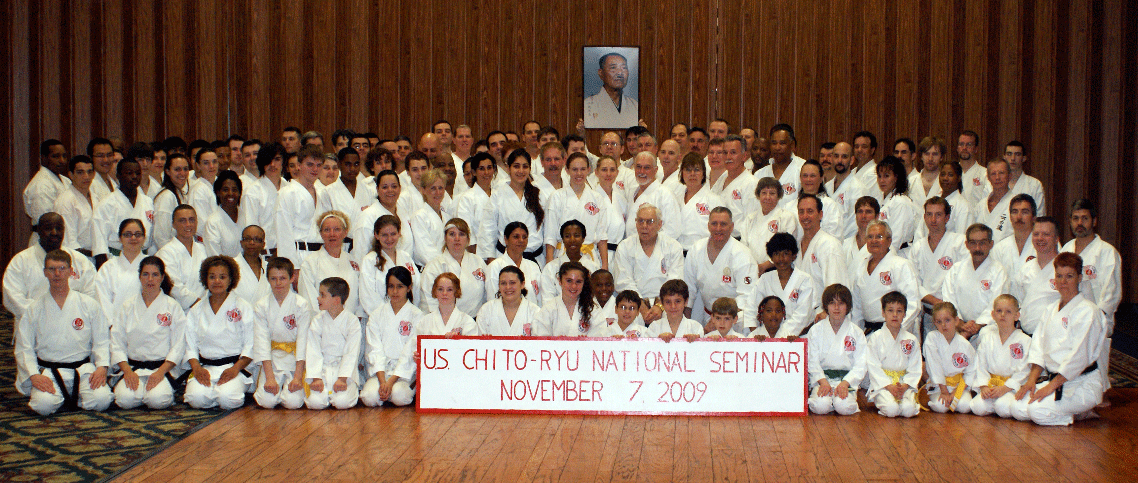
The clinic itself got off to a great start in a spacious room with Hanshi at the helm. Spending about an hour and a half practicing and refining Chito ryu basics, the kyu ranks in particular got some bite size instruction to
really clarify the foundation of our basics. Dan ranks seemed to seize the opportunity to simply train hard, but also to reinforce their understanding and, in particular, to learn some great instructional tools. It didn’t hurt
that we got a nice sheen of sweat going.
We were all pleased and honored to welcome Jean Noel Blanchette Sensei of Quebec Canada. Blanchette Sensei had very interesting and enlightening perspectives on the practice and benefits of Chito-ryu. Though they have not
trained together extensively, sensei remarked on how what he does is the same as what Hanshi had been emphasizing the previous hour. He proceeded in the next couple hours to teach these broad principles in very simple one and two person
exercises. Two really basic concepts to take away are that when you execute a technique, of course you must root to the ground and lower your center. If you think about executing the technique from the lowermost crease beneath your
buttocks, this really helps to generate power from the appropriate portion of your anatomy. Also, as we know, the pulling in any technique is even more vital than the pushing. The hiki te, or separation of hands, for example should not
be done haphazardly. Rather, the abdominal muscles should be utilized to pull sharply.
Sensei also apologized several times for referring to his religion in the context of his karate training. He actually wrote a 250 page thesis on the spirituality of Chito-ryu or karate training in general. For my own part, I
viewed the depth of his knowledge and study with fascination. To me, it was yet another individual who sees that a lifetime of karate leads to more than just great technique. For those who are willing, your training can touch you on a
metaphysical level. Regardless of religion or personal beliefs, at some point, karate fuses with your ‘soul’, your spirit, your very essence. One more reason to keep at it for life.
Time flew by and before we knew it, we were fresh smelling and seated for banquet. I found the food was much improved in our time away from the Drawbridge, so that was nice. For future reference, please indicate any special
dietary needs on your banquet reservation. The Drawbridge did accommodate some last minute changes, but next time we can be proactive, plan ahead and it will make life easier for Okusan. There were many awards, promotions and
recognitions for 2009. Congratulations to all! But whether or not you got a promotion, award, a thanks, a door prize (dang it, I never win a door prize!) we do what we do because we love it, we see lofty purpose to it, and we want to do
it. Gratification must be inward. One more reason to keep at it for life.
Next stop, Kangeiko.
Mina K. Ludwig
Yoseikan Yoshisu
Cincinnati, OH
Kagami Biraki 2010
On Sunday, January 10th, the U.S. Chito-ryu Hombu hosted a group of 40 plus karateka for the 2010 edition of KAGAMI BIRAKI. A traditional martial arts gathering /workout to welcome in the new year.
An annual event
coordinated by the D.N.B.K. (Dai Nippon Butoku Kai), all D.N.B.K. dojos throughout the world train on the same day and time to collectively gather a critical mass of positive energy for the purpose of bringing peace, harmony and good
will into the new year.
With the beginning of a new decade, and at a time when there is so much turbulence in the world, there could be no better time to promote good will toward all mankind, and to foster the development of the the
positive characteristics which traditional martial arts aspire to produce in their participants.
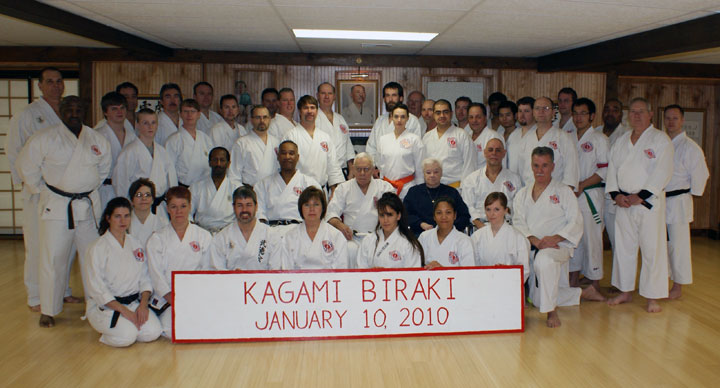
The atmosphere at the Hombu dojo was absolutely electric. Black belts were lined up across the deck and four rows deep as Dometrich Hanshi led the formal bowing in to start the training session. The karateka represented several
U.S.Chito-kai dojos from the tri-state area. Also present were Dwight Holley, Kyoshi with several members of his organization, and several karateka who had trained with Sensei Charlie Williams. (Oh yes! Let’s not forget, the
future was represented by a nice sized row of kyu ranks).
Dometrich Hanshi, invigorated by not only the number but also the enthusiasm of the participants, saw to it that the energy level stayed at an extremely high state throughout
the entire class. He led the way for the first hour, taking everyone on an energized journey of kihon and kata. With limited space on the deck, all present had ample opportunity to practice their in-line stances and turning. Thanks to
Hanshi’s leadership, it wasn’t long before gi were soaked and the mirrors were steaming up.
The second half of Kagami Biraki was turned over to Kyoshis Hawkins and Beshears, and several other ranking yudansha who each
led the group for a vigorous twenty minute session.
Great moments never seem to last, however if everyone who took part in this years’ Kagami Biraki dedicates themselves to maintaining the energy and attitude exhibited at the
Hombu then the new year and decade will be off to a great start.
Dometrich Hanshi led the formal bowing out to end the training. Afterward one and all stayed to share a meal and to make new and to renew friendships. As always, the
kitchen staff did a fantastic job. Thank you.
P.S. Due to the logistics of distance, time, and the economy not all D.N.B.K. members could gather at the Hombu this year, yet held their own Kagami Biraki locally.
Wishing all karateka a healthy and harmonious NEW YEAR.
John Wellbrock
Yoseikan Hombu
Kangeiko 2010
This past January marked the 30th Kangeiko for the United States Chito-ryu Karate Federation. Wait…what? Shouldn’t the 30th have been last year? Well, yes it should have, but Old Man Winter had too much fun
laying down lots of snow and ice, and then topped it all off with a bonus round of more snow. That prompted Okusan and Hanshi to reluctantly cancel the event, which was the first time ever.
If you are a part of this Organization you
have undoubtedly heard about Kangeiko, though you may have some misconceptions. Let’s clear the air for a moment. Do you get much sleep? Depends. We didn’t, though from the snoring heard echoing in the dojo, some people did.
Was it cold? The outside temperature was around 14° F and the deck was chilly at first, but after a few minutes of deck drills the cold all but disappears. Did the instructors tear you down physically and mentally? It was quite the
opposite actually. Encouragement and helpful instruction was plentiful. Was it six hours of basic training? No, not at all. The basics were there, of course, but we also carried on the tradition of being taught “secret ninja
techniques”.
Speaking of tradition, we have heard tales of the pre-Kangeiko feast and the stories are true! The food was absolutely delicious (loved the pasta sauce) and never-ending. Many thanks to all who helped prepare the
meal especially Okusan and Paul and Kathy Webster. The evening was filled with wonderful conversation from new and old friends and concluded with a speech from Sensei Schmidt informing us of some of the rules: training would last six
hours, no talking, and all clocks would be removed. The theme this year was Seiryoku Zenyo, roughly translated as “maximum efficiency with minimum effort”.
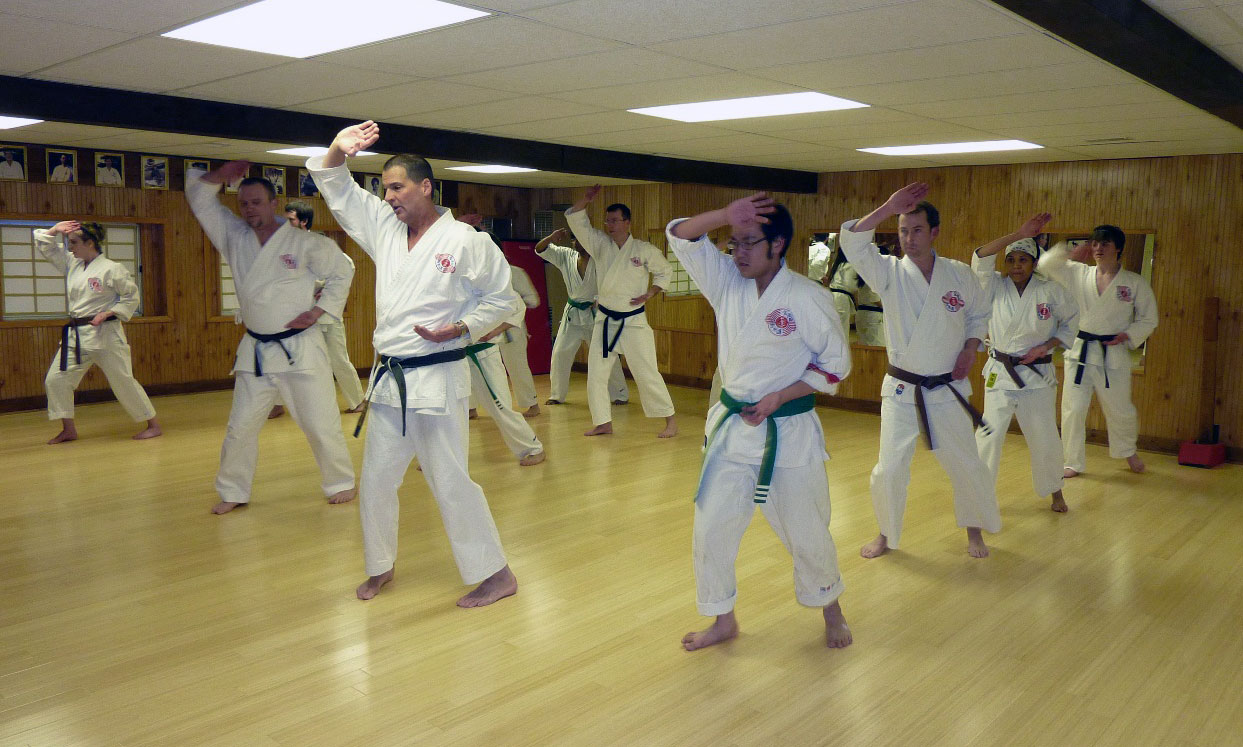
At 2:30am the alarm clock rang and eighteen bleary-eyed karate-ka immediately began to quietly clear the decks of sleeping bags, air mattresses and fluffy pillows. After bowing in and what seemed to be five minutes in
seiza the 30th Kangeiko was fully under way! To get the body warm we performed some light stretching and various deck drills such as blocks (several hundred), kihon dosas, and other basic kata. All of us moved through Sanchin and on to
Seisan but Sensei Schmidt and Sensei Jansak surprised us by going over and thoroughly examining wrist releases and even an oldie but a goodie, Kihon No Empi, but with a twist. It was a wonderful experience working the various parts of
the kata using a kicking pad. The transfer of your body’s weight, the amount of hip snap and the speed of the elbow all played an important part in getting “maximum efficiency with minimum effort”. With several of the
students moving the “big boys”, everyone soon realized how dangerous and even deadly an empi can be. Water breaks were given at regular intervals along with numerous stretching “intermissions”. A tremendous honor
was bestowed upon all who attended by being given the opportunity to learn Chokusen. This is a kata developed by Hanshi with the purpose of revealing techniques that can be put to use in a confined area such as a narrow hallway. Going
through it for the first time reminded us of keeping a “beginner’s mind”, an ideal that may too often be forgotten.
Sooner than many expected, Sensei Jansak began informing us of the formation we would keep while
running through the beautiful streets of Covington and shouting to a cadence written by Hanshi. The idea was that the words would help keep our minds from thinking about how cold it was, how tired we were, and what time it was. What
time was it anyway? Well, Kangeiko always ends with a run so the end was near, right? Not so fast fellow karate-ka. After arriving back at the Hombu we adjusted to the slightly warmer temperature of the dojo by running some more but
also noticing something was amiss…where was that sweet smell of breakfast? For the last hour or so we concentrated on kumite with both instructors giving each and every student expert instruction and guidance. By this time many
were struggling both physically and mentally, but powered through it all. Eventually it was time to bow out. Tea was graciously offered to everyone by Sensei Meade and enough delicious food to feed an army was waiting for everyone in
the kitchen.
We would like to thank everyone who participated in and worked hard to make the 30th Kangeiko a huge success. On a factual note, there were eighteen karate-ka on the deck this year and also eighteen the very first year.
We would also like to mention a few aspects of the event that we really enjoyed. First was the pace of the training. It wasn’t too fast or too slow. It was just right. Second was the regular stretching breaks. We didn’t
think we’d be able to walk after six hours of training, but that wasn’t the case at all. Apparently the leg massages really worked. Great idea Sensei Jansak! And finally we really enjoyed working with many different
students. The frequent rotations provided the opportunity to train with students whom we’ve seen many times at other events of clinics. Hope to see everyone back at next year’s Kangeiko!
Joe & Jenny Benzinger
Yoseikan Anderson
Three Quarters of a Century Down, No Problem
By Mina K. Ludwig, Yoseikan Yoshisu
For his 75th birthday celebration, Dometrich Hanshi had spirit and energy to spare. The turnout for the annual Spring clinic was great. We were joined by our good friend whom we can never call a guest, Holley Sensei,
along with some of his hard working students. USCK dojos from West Virginia, Virginia, Florida, Ohio and Kentucky were all well represented and everyone’s spirits were high. It’s been a long dreary winter, and we are all looking forward
to Spring training in the USCK.
After a dynamic warm up, Hanshi got everyone started on basics and two person drills utilizing Chito-ryu basics. Simple, efficient attacks and counter attacks – he ran us through a gamut of variations.

Many of the Chito-ryu basics appear in Hanshi’s kata Chokusen. By popular demand, we worked on this kata that Hanshi developed back in the 60’s. As I’ve heard Khalily Sensei remark, anyone can make up a kata. But the
foundation of kata is classically based upon combat – not a showy grouping of techniques. What is at once unique and credible about Chokusen is that it is based upon Hanshi’s very real combat experience. As a police officer, Hanshi
often found himself in hallways and narrow alleys with thugs who, in order to save their own hides, sought to do him bodily harm. For each technique, Hanshi has a story about “One time, I had a guy try to ….” So, yes, anyone can make up
a kata. But not everyone can formulate a legitimate one.
Moving on, we spent a good bit of time working on Kusanku-dai. For many this was brand new. For others, it was a good opportunity to drag this kata out of the memory banks. Long and complex, several repetitions of this
kata is truly a full body work out.
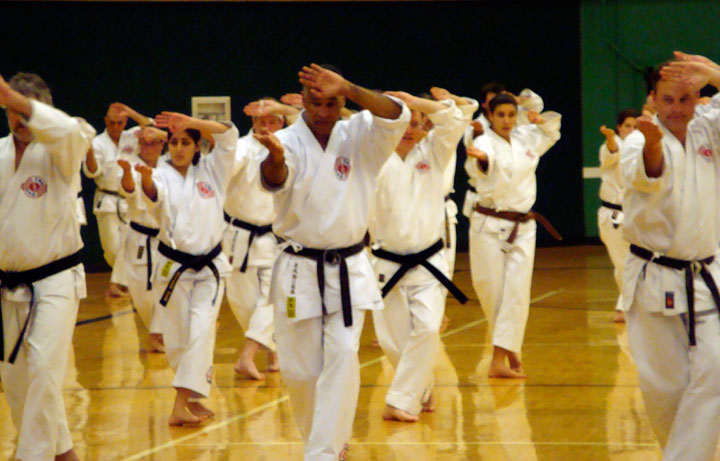
Many thanks to Sherry Kembre, Mark Chisenhall, Don Schmit, John Wellbrock and Laura Stith for their expert teaching assistance to Hanshi.
The day culminated in the spontaneous promotion of Terry Collis Sensei to the rank of roku-dan. For anyone who has not had the opportunity to train with Collis Sensei, you are missing out. At 70, he puts most folks to
shame with the level of intensity and spirit he puts into his training. His promotion by Hanshi was met with heartfelt applause.
Hours later, a fresh dapper crew appeared at the Hombu dojo to continue Hanshi’s birthday celebration. As always, there was food, drink, exaggerated stories and laughter to spare. It was a great turnout for Hanshi’s
birthday and he was clearly touched by all of the well wishers and the thoughtful gifts.
Thanks again to Okusan for all the time and pains taken planning. Much appreciation to Kathy and Paul Webster for the cooking. Thanks also to Nori Sakastume for the fantastic clinic t-shirt design. Many, many others
helped and we all value your contributions as well.
Until we all meet again at the end of July for Shochugeiko, train hard. As Hanshi is likes to say, “Sweat, sweat, sweat.” See you soon.
Kyoshi Barbara Dometrich (Okusan) is featured in the Fall 2010 issue of Masters Magazine
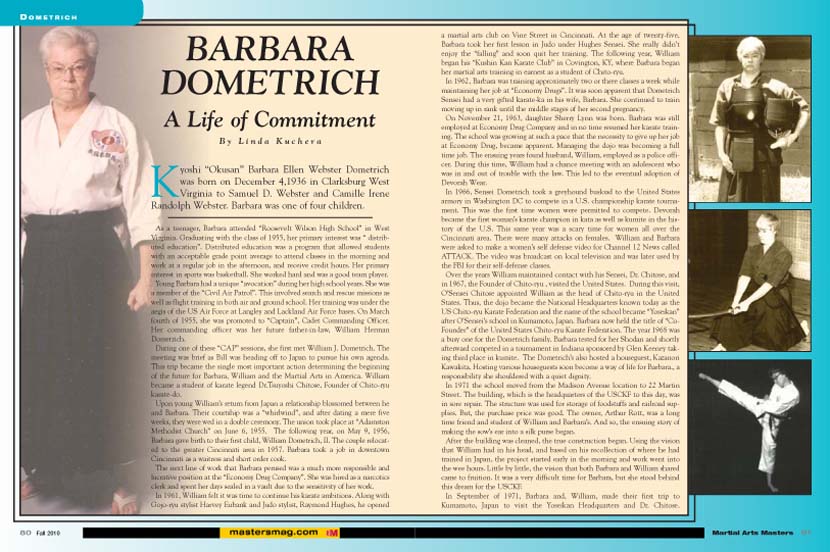
www.mastersmag.com
ON SALE JULY 22nd
IN BOOKSTORES & PREMIUM NEWSSTANDS
Or call: (818) 767-7900
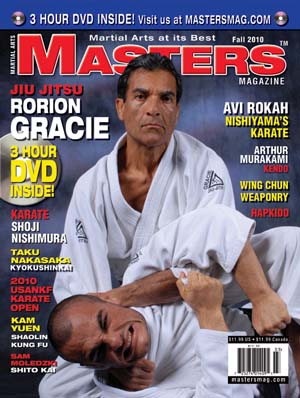
A Look Behind the Scenes
USCK National Clinic, October 2010
By: Mina K. Ludwig
Before we ever get to the training, a lot of work has already been completed behind the scenes. Even beyond the tedious preparations, detailed schedules, travel arrangements, venue contracts, registrations and so forth,
there’s so much mind boggling “stuff” happening, you’re better off not knowing.
So of course, I’m going to tell you all about it.
For those who plan to test before the National Test Board – be prepared. Pay attention to detail and turn in all of the required documents, fees, pictures, and essays in a timely manner. Do we read it? Yup. Do we
look at your test score? Definitely. Does neatness count? Duh. Someone once said that karate-do is about how you line your shoes up against the wall. Tsune, or daily habits, is how we make karate-do a part of our essence and everyday
lives. Every day is a test. If you believe that, and you believe that it all begins with the smallest detail like how you arrange your shoes, testing in front of the National Test Board will not be a problem for you. Slackers
beware.
Having said that, everyone did well on Friday October 15th. Hanshi was happy, so everyone was happy. He was happy because every single person who tested had a great attitude. They came ready to work hard, sweat, and
perform to the very best of their personal ability. There is a lot of improvement to be had, but the right attitude and work ethic will allow us to strive towards bettering ourselves on and off of the deck. However, there are some
technical issues that need to be addressed across the board:
No technique is executed with a ‘limb’. Whether it is a punch, kick or a block – everything generates from the tanden and (more broadly) the koshi area. While we loosely translate koshi as ‘hips’,
but the area extends from the tops of the thighs to the area below the sternum. A violent, explosive ‘snap’ of this area is what sends forth the weapon, i.e. the limb. So while we saw some hip movement, please keep working
on the body connection. In Chito-ryu, our waza begin and end with some movement or engagement of the hips. However, absent the body connection, practitioners are prone to displaying a mere ‘Chitose wiggle.’ A wiggle is
decidedly not O-Sensei’s legacy. So there needs to be a strong emphasis on hip snap, or engagement, which supports the waza. The more advanced you become, the smaller and more subtle the movement. Ultimately we are striving
towards internal power, but we ain’t there yet so for now let’s see the right kind of movement.
At the clinic, Sensei Tsuruoka admonished against ‘right angles’. If you are ever told that your technique looks ‘boxy’, this is likely the right angle phenomena. For example, a front kick in the
fully extended position - the hips should not be square. The side with which you are kicking should be extended beyond the center line. This principal can be applied to all kicks, but the opposite problem must be avoided – don’t
overcommit the hips prior to the point of impact or focus. We saw some mawashi gerri where the kicking knee and hip had already crossed the center line of the body before the foot even thought about getting to the party. Hips start and
end the technique.
Also with kicks, the knee must be raised high and must return high. Only by utilizing the same trajectory to and from the target can one hope to achieve optimal snap. Snap a towel out and return slowly or drop the angle
of the return pull, and that towel simply will not snap, crackle, pop. Practice your kicks with the proper foot position and with some ‘hang time’ once back to the return position.
Don’t open and close your fists. If you are making a fist, make it and keep it. The tightest part of the fist is the pinky, but the whole shebang should be very tight. Fists should be tight, but arms and shoulders
should remain loose. (Hint, if your shoulders get closer to your ears, they are not relaxed.) Test your students or yourselves by trying to put your finger inside someone’s fist. With a properly clenched fist, nothing’s
getting in there. Practice your open hand position as well. All knuckles disappear except for the very first knuckles which curve to bind the fingers together. It is very rare that those top knuckles are bent independent of the other
two knuckles, so it takes a lot of practice to make this feel natural.
When advancing by way of yori ashi, or sliding feet, in neko ashi dachi, you must advance heel to ball. So extend your leg forward, put your heel on the ground and roll up on to the ball of your foot while sliding your
back foot forward. If you put the ball of your foot down first, this is like a door stop and it inhibits further forward motion.
Everyone please continue to improve your posture. A straight spine with well-spaced vertebrae was a point of great emphasis for O-Sensei. Proper body alignment optimizes all techniques whereas poor body alignment
disconnects the body from the power source and contributes to poor waza. You will notice incredible posture among the best budoka, which is why Sensei Tsuruoka emphasized posture at the clinic as well.
Congratulations to one and all who tested prior to the 2010 clinic. Thank you for your diligent preparation and strong spirit. Wear your new rank with great humility knowing that you have a lot of work and learning yet to do.
Aspiring test takers - bring your ‘A’ game.
Not done yet… the very next morning, prior to the clinic, all dojo heads and shihan met to discuss the year past and the year to come for the USCK at the annual Board of Directors meeting. Growing the organization
is always a priority, but we wish to do so in a prudent and far-sighted manner. Those who wish to open a dojo will need to have a precise plan which includes a financial analysis and a plan for gaining new students. Within the USCK our
practice of karate is not designed to make money. Ask any of the school heads and you’ll find out that you’re gonna need to keep your day job. Karate is our passion, not our bread and butter. Still, if a dojo is bleeding the
instructor dry, it simply will not last. If you run into problems, let someone know. Okusan is a great resource. In addition, anyone within the Board of Directors would far prefer to advise and mentor than to see a dojo fall apart.
Thinking of starting your own dojo? Great. Let’s go about it the right way. Get in touch with Okusan and she will steer you in the right direction.
Speaking of supporting dojo, when there is a clinic hosted by one of our shibu dojo – we need to try very hard to get there. If you have not experience W.Va yet – you need to get there. It’s a lot of
work for the Drummonds and Messinger Sensei. But for the participants it’s just good, clean fun. The next shibu sponsored clinic is the Florida getaway in February. I’ve had to miss the last couple of years because of other
travel – but this year, I’m bringing the noise! Acampora Sensei, et al – we will be there so have my tropical drinks with the little umbrellas ready please. The date is not yet set in stone, but it needs to be. The
clinic will take place either the weekend of February 11th, or February 25th. The Board collectively decided to skip over the President’s Day holiday because airfare and travel is harder with all of the Daytona 500 traffic. If you
have a strong opinion about which of those two weekends – express it now because that decision needs to be made before Thanksgiving.
Now, thoroughly exhausted, it’s time for the clinic. Sheesh! More details on the clinic and banquet will follow in separate articles. Suffice it to say that Sensei David Tsuruoka wowed us again with the simple yet
very effective drills which emphasized some of the most important aspects of our training. It is always a great affirmation to have a thoughtful, respected and skilled karate instructor echo your own priorities, admonishments and
encouragements. Much of what we worked on, we have been working on in black belt class or our regular classes. This is not to say that the clinic was redundant – far from it. Sensei Tsuruoka, showed us some fun new ways to skin
the cat. (So now, we can have a bunch of bald cats - skinned in various manners…) Often the same lessons resonate more effectively when they come from a fresh voice. Thank you Sensei Tsuruoka, once again, for sharing your spirit
and your knowledge so generously. We hope you will be back very soon. As always, please give our very best to your father. (Anyone else get a glimmer of the Terror of Kyushu when poor Adam was getting smacked around?)
Next stop is Kangeiko. Then, the March clinic. Watch for emails about ordering commemorative items for those events. Got an idea? Drop me a line. It’s just one of many and sundry things that go on ‘behind the
scenes’. (Dramatic music here - Da, da, da, daaaaaaa!)
A Weekend to Remember
By: Jen Benzinger, Yoseikan Anderson
I have to admit that I was more than a little nervous about testing for my Ik -Kyu this October in front of the National Test Board. After all, I had never tested anywhere except my own dojo in front of my own teacher
and fellow students, and that was nerve racking enough! I walked into the Hombu on Friday evening reminding myself that all I could do was my best and hope that it was good enough. I was welcomed warmly by everyone there, which, along
with a lot of praying, helped to ease my nerves.
I didn’t really know the other students testing, though I had seen most of them before at other clinics. By the end of the night, I felt a connection to all of them. The test went by in a blur. The deck drills were not
too complex (to my relief), but they were numerous and speedy and definitely got us warmed up. Then it was on to kata, in small groups and individual. Lastly was San- bon- kumite and Ippon- jiyu- kumite. Then…the wait. Sensei John
Wellbrock came up to the upper deck where we were all waiting and informed us that the board had decided that those of us who were on the fence would have to spar each other. The winner would pass and the loser would be back in March to
retest. You should have seen the looks on our faces before he told us he was just kidding. I can laugh about it now. He really had us going there for a minute!

Shortly, the test board had the results and had some helpful critiques as well as praises for each student. No one was perfect, but that’s not really the point of testing. Testing is a time to show what you can do and to
learn the areas where you need to practice more and improve. In the end, 13 people tested and 13 people passed and all were given some areas to work on. It was a great experience.
After a long, emotional night at the Hombu, it was time for the annual October clinic at the Drawbridge Hotel. We started the 4&1/2 hour long clinic with a quick warm up and then Hanshi Dometrich led us through an hour of
Chito Ryu basics. It’s always good to go back to basics and polish up on things that we assume we are doing correctly, but maybe have become sloppy or rusty with. Then our guest for the weekend, Sensei David Tsuruoka from Canada, took
us through the next 3 hours. He emphasized the importance of hip snap and speed. He asked us not to “think” about technique, as this can cause you to slow down. He reminded us that speed and power come from the tanden and that the foot,
fist, elbow, etc. are only a vehicle with which to transfer the energy to the opponent. We worked on many bunkai and applications to reinforce his teachings. I was exhausted by the end, but amazed that 4 & ½ hours had gone so
quickly.
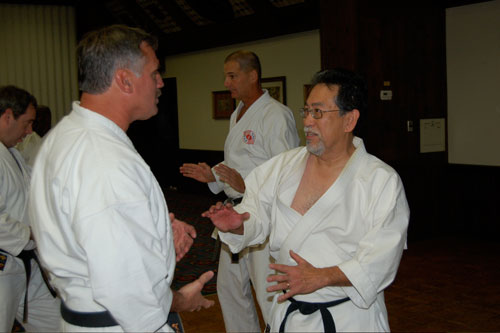
There was just enough time to rush home, shower, change and make it back to the Drawbridge for the annual October awards banquet. It was great to see so many faces, some new and some familiar, from dojos throughout the
states. I had the pleasure of sitting next to and conversing with Sensei Jesse Brown from Rochester, New York who gave a beautiful opening prayer and closing benediction. The food and conversation were wonderful and it was inspiring to
see everyone who received awards and promotions. Sensei John Wellbrock did a fantastic job summing up the highlights of the past year, complete with costume changes- very impressive! The best part was when he presented Sensei Mina
Ludwig with fabric freshener and a broom for the next time she made her infamous “witches brew”!
After the banquet, it was nice to unwind around the pool and to see Hanshi and Okusan finally get to relax. Tsuruoka Sensei was a delight to talk to and after a couple glasses of liquid courage, I finally got the nerve to
get my passport signed by many if the sempai who have inspired me these last 4 years. I want to thank everyone for being so gracious and a special thank you to Hanshi and Okusan and all those behind the scenes who made this weekend a
success and one that I will never forget.










 Even though we were not able to practice walking out we had very good formation. The Shotokan group headed by Sensei Dwight Holley demonstrated Bassai Dai kata and Sensei Holley impressed everyone with Hakaku kata
Even though we were not able to practice walking out we had very good formation. The Shotokan group headed by Sensei Dwight Holley demonstrated Bassai Dai kata and Sensei Holley impressed everyone with Hakaku kata


 A few special awards were given, such as the gold medal won by Eric Ernst from his world championship win in kata to Hanshi. Eric and his brother Alec and father, Wes, traveled to Italy in September for the
competition. The Ernst family showed off the beautiful championship trophy. Many members of the Chito-kai pitched in to help cover the expenses and the Ernst family wanted to thank everyone for this opportunity and to show their
winnings.
A few special awards were given, such as the gold medal won by Eric Ernst from his world championship win in kata to Hanshi. Eric and his brother Alec and father, Wes, traveled to Italy in September for the
competition. The Ernst family showed off the beautiful championship trophy. Many members of the Chito-kai pitched in to help cover the expenses and the Ernst family wanted to thank everyone for this opportunity and to show their
winnings.


























